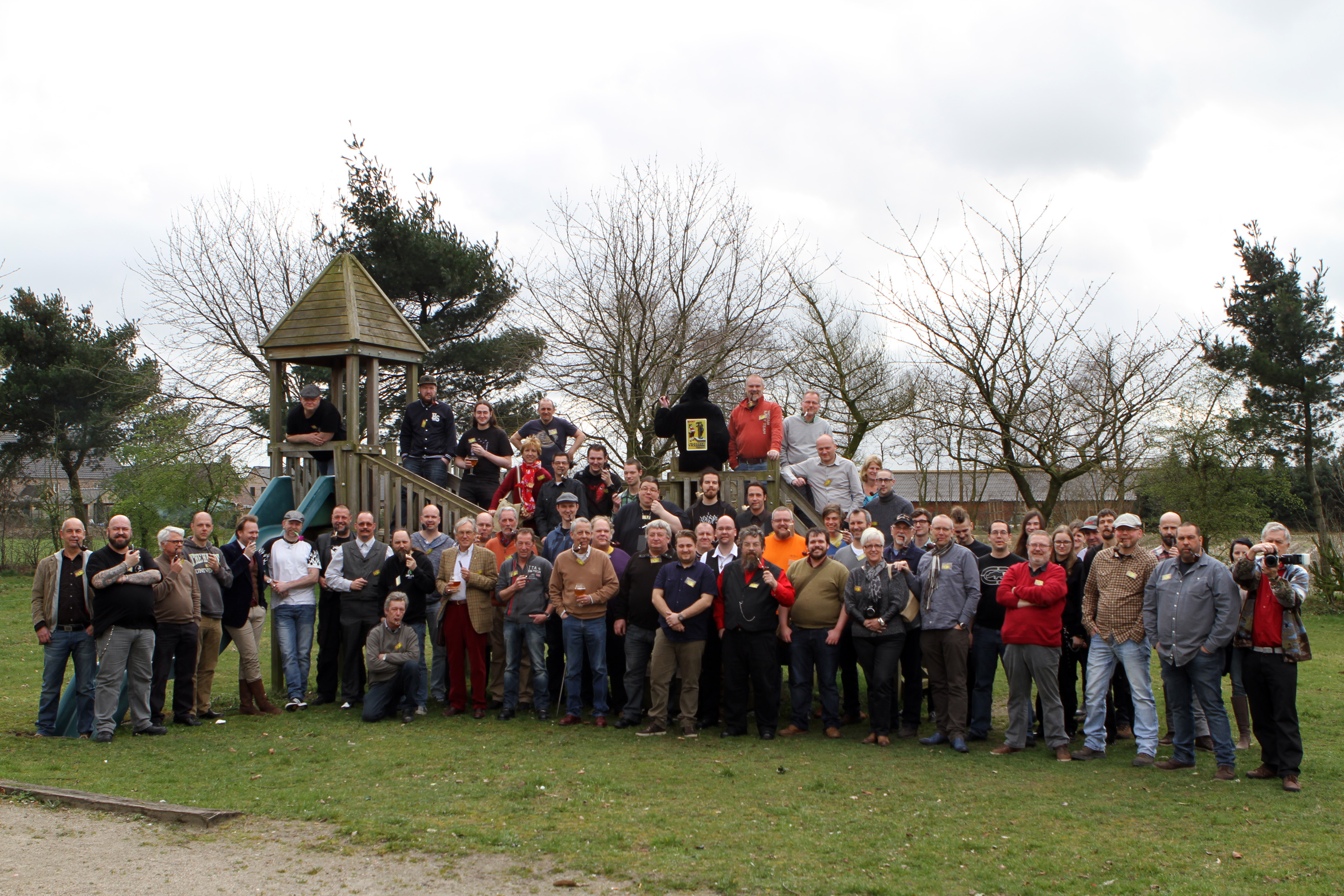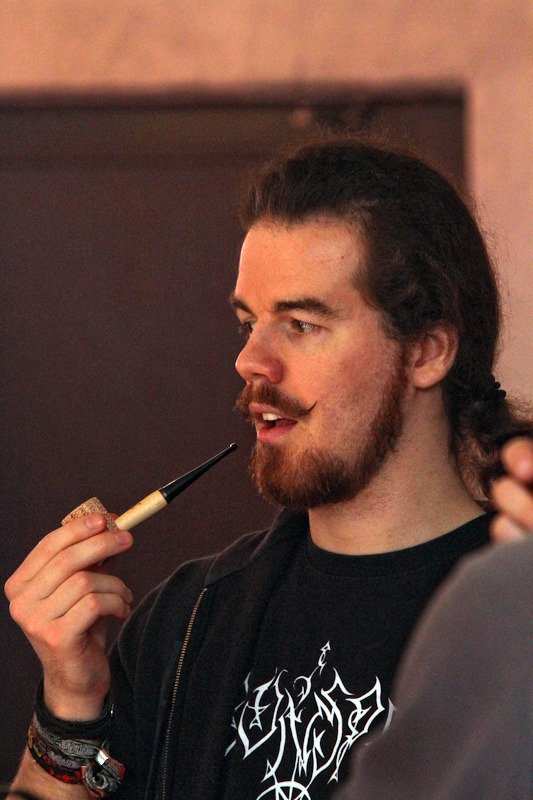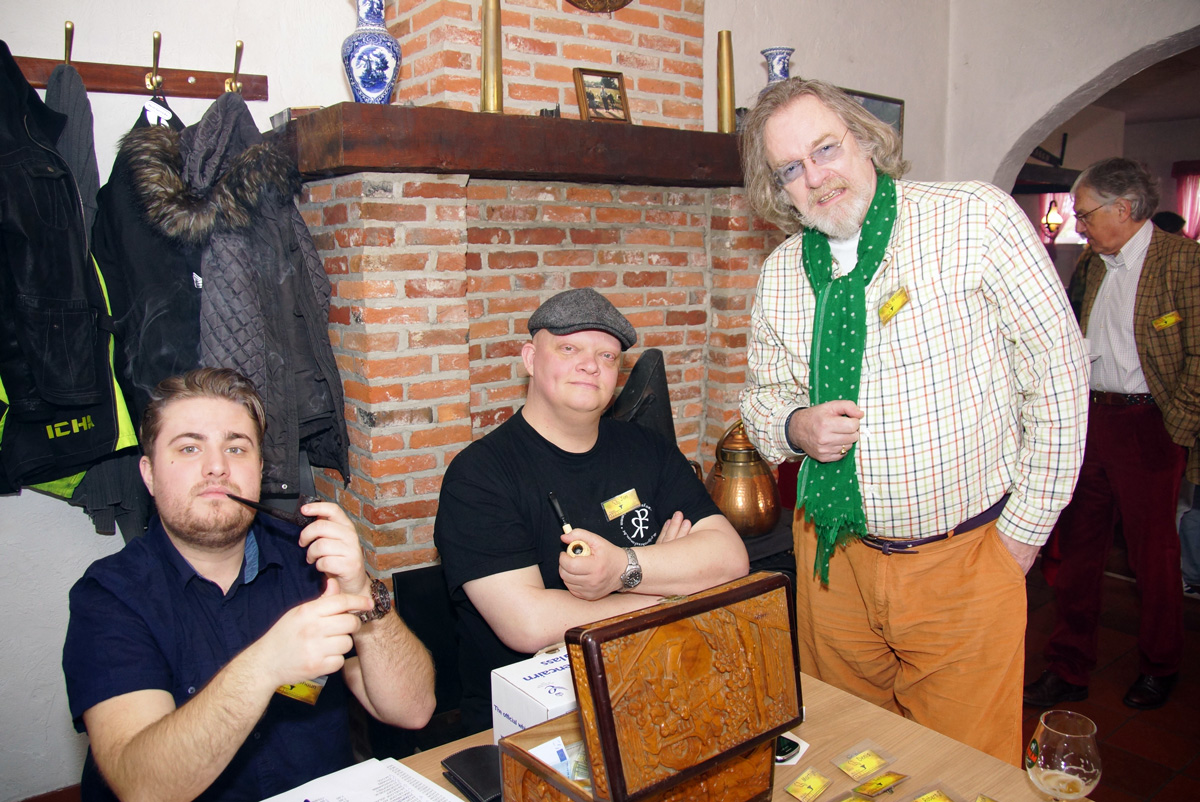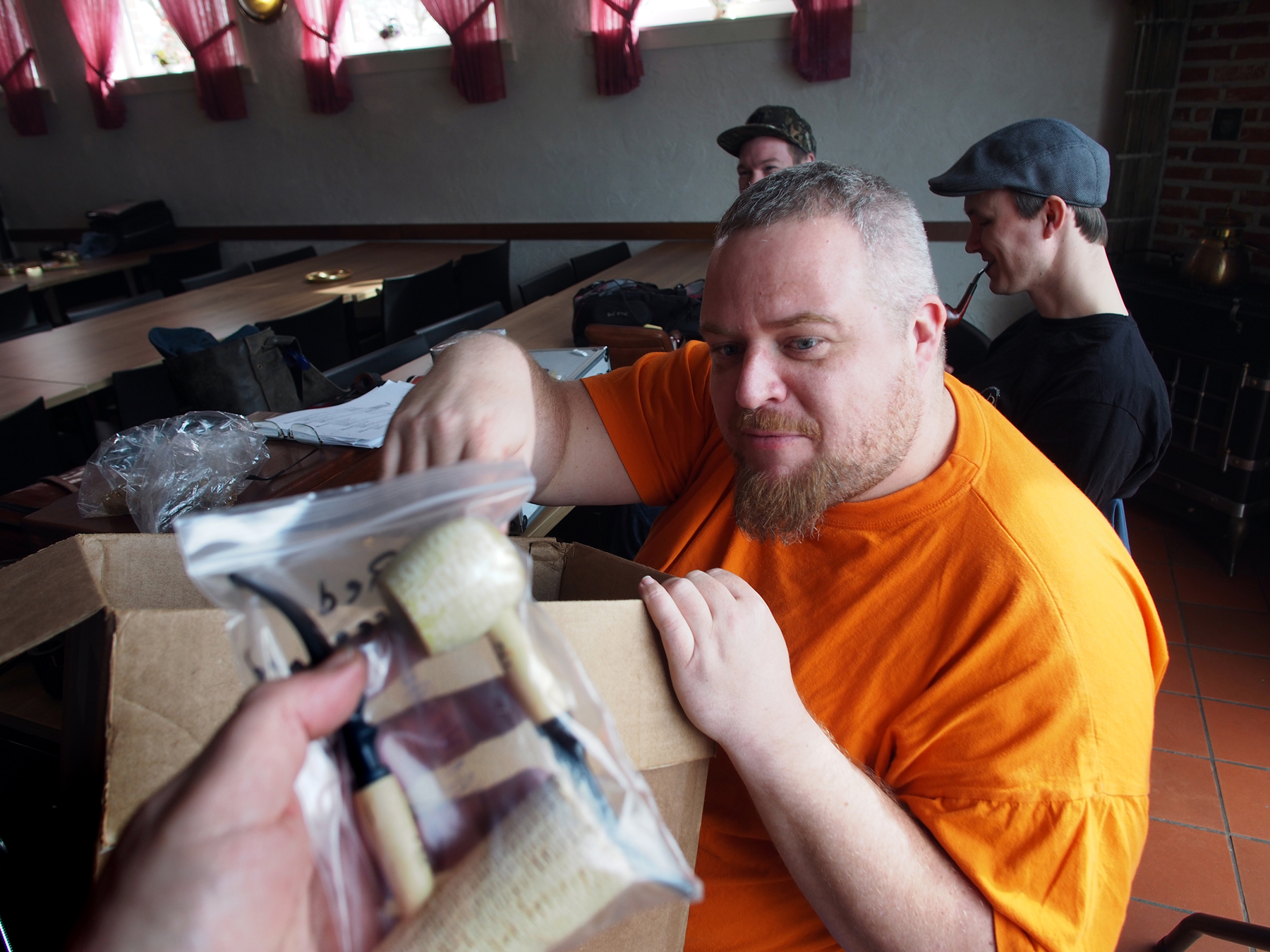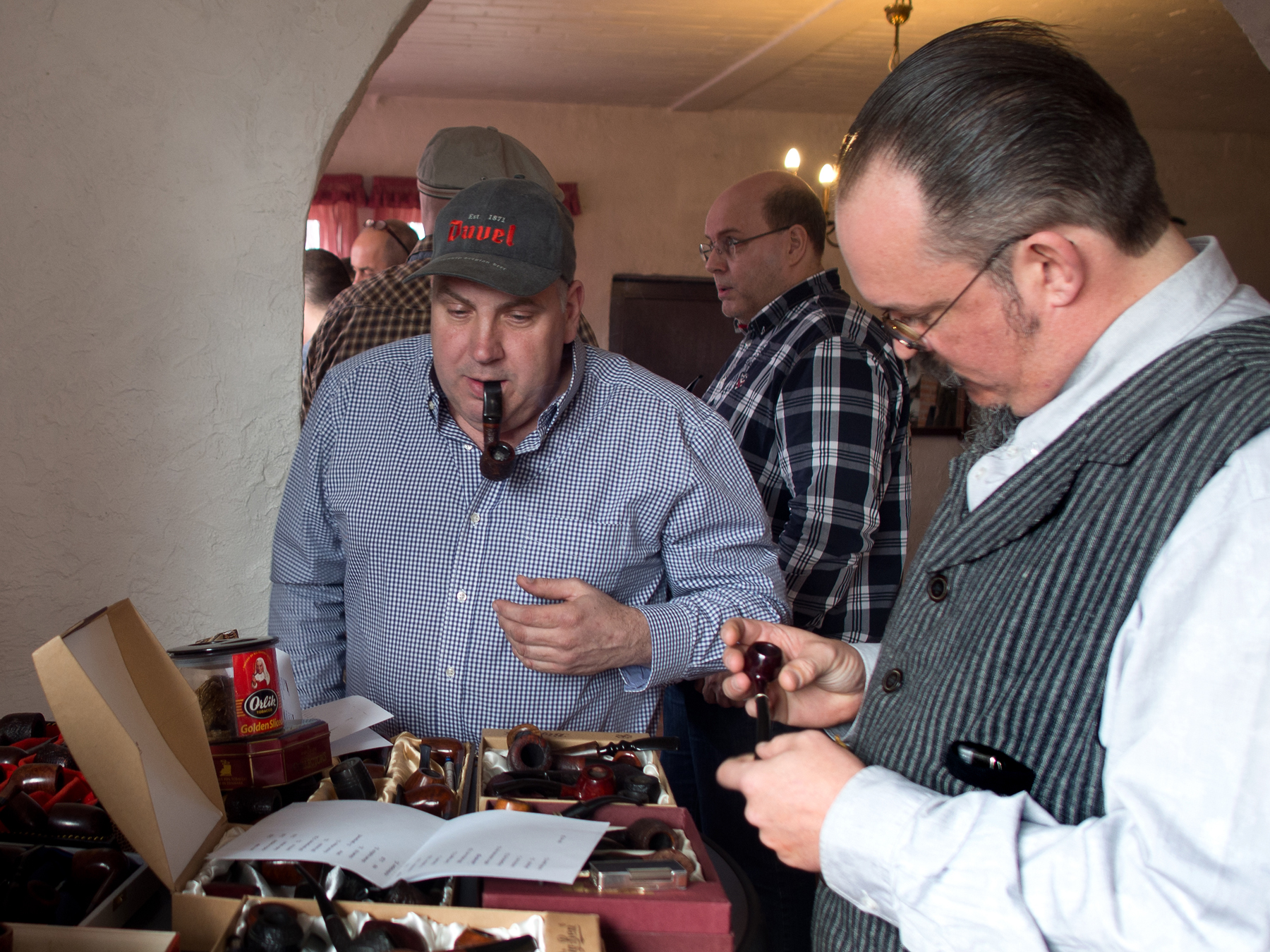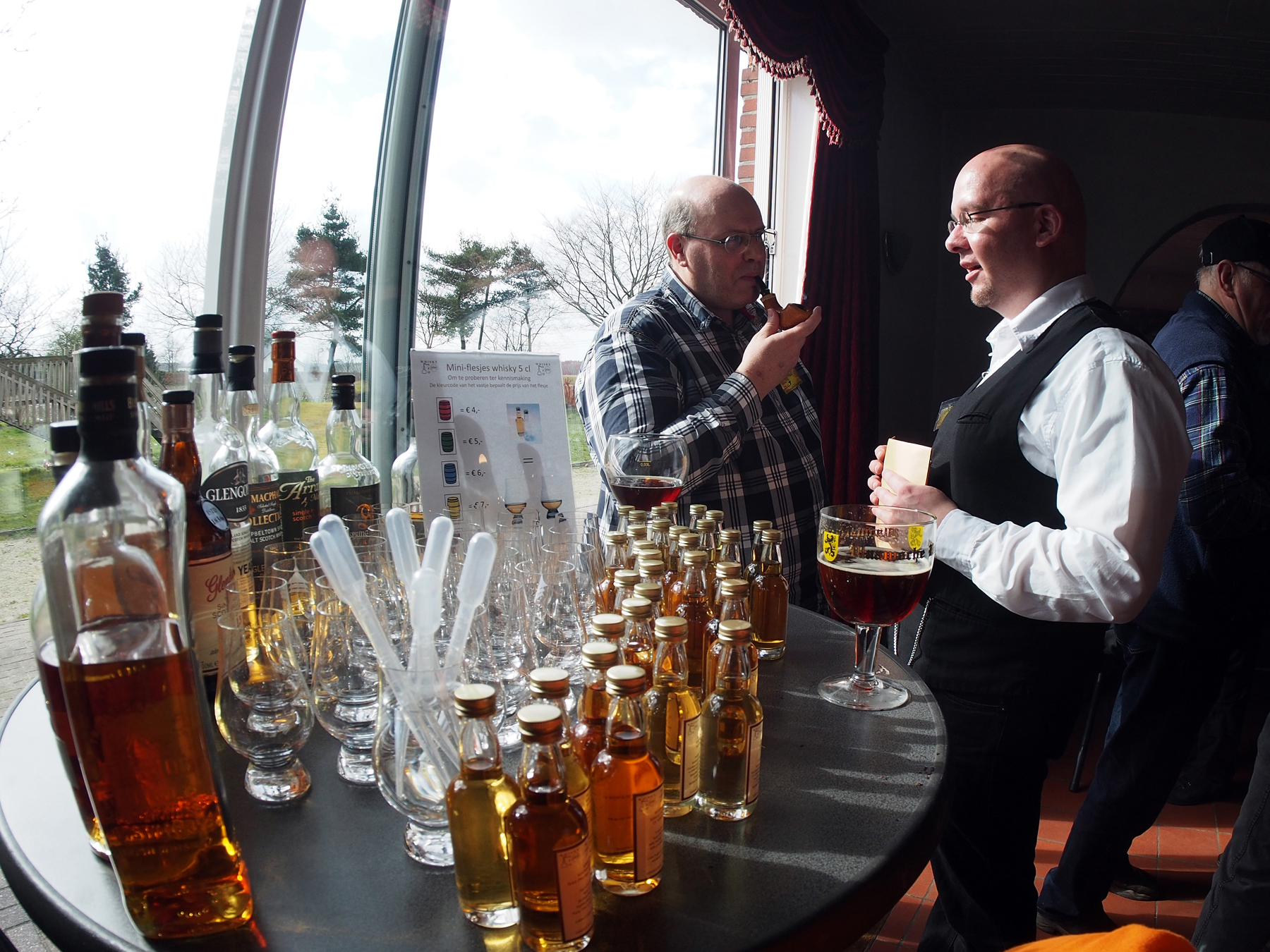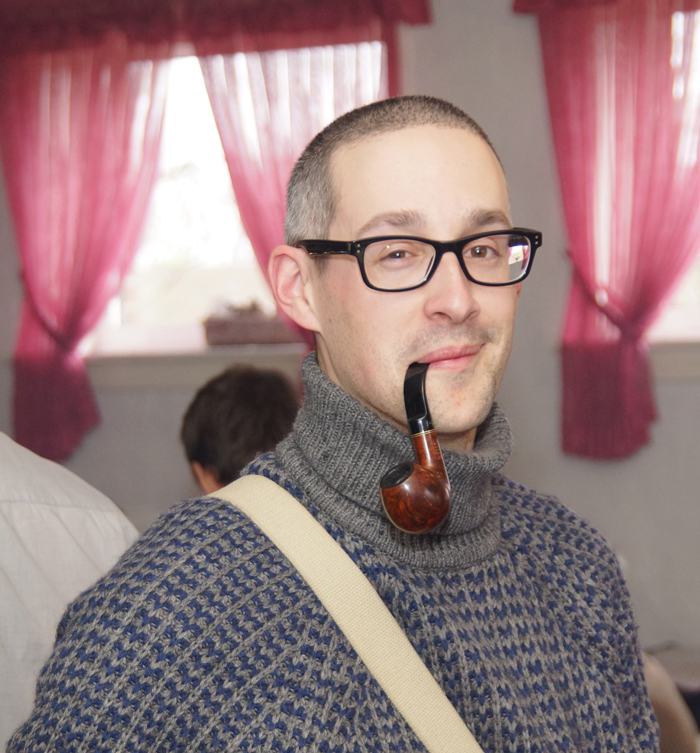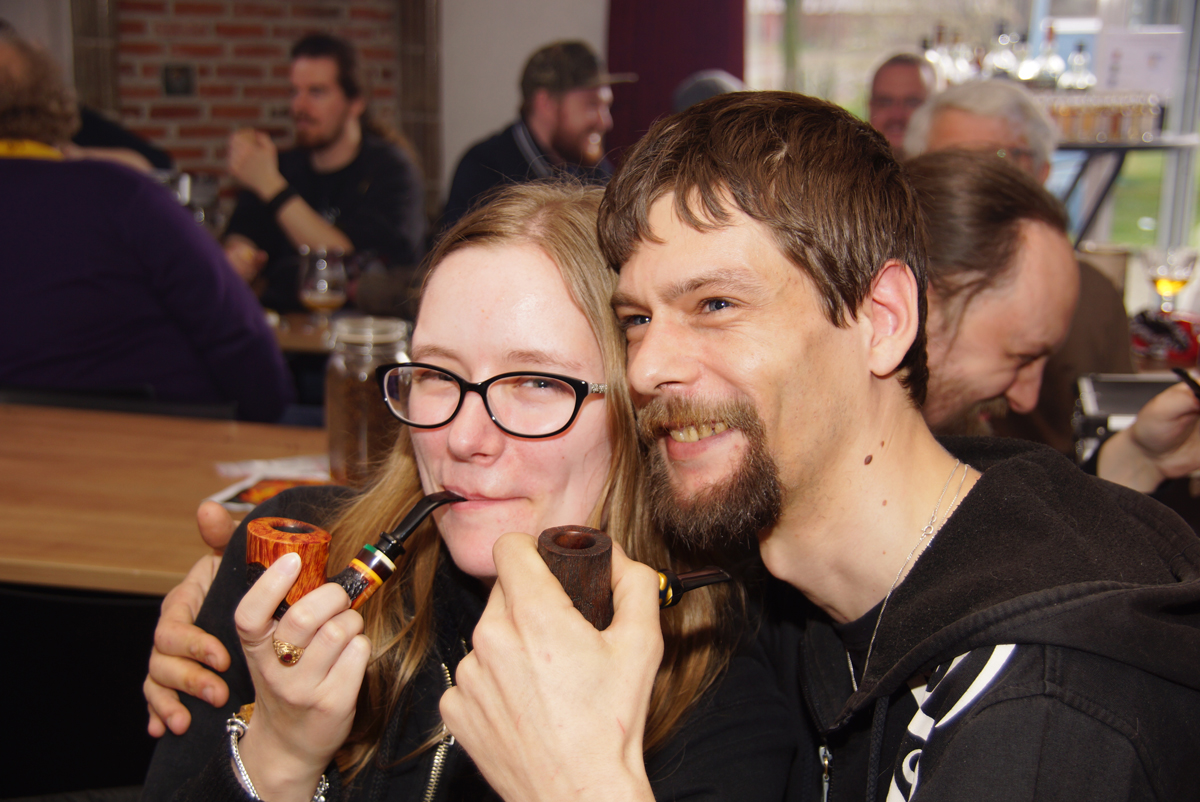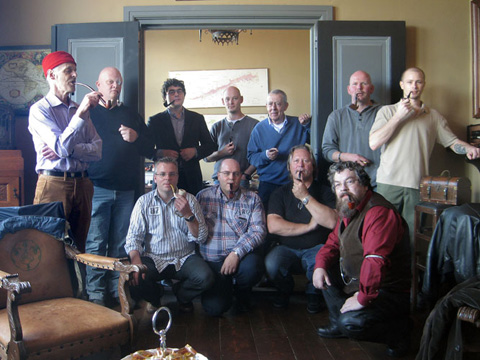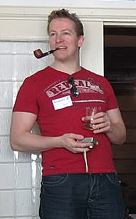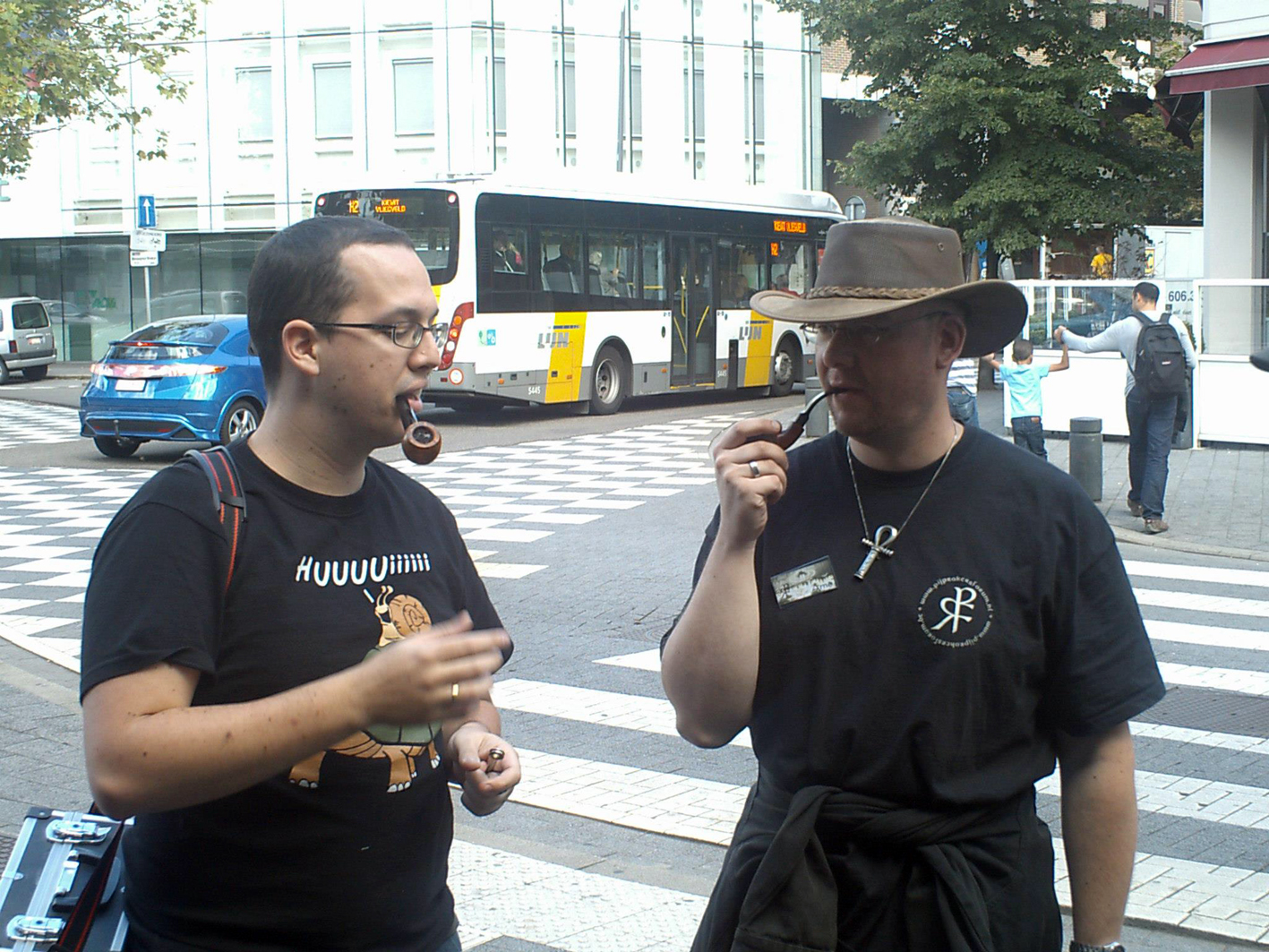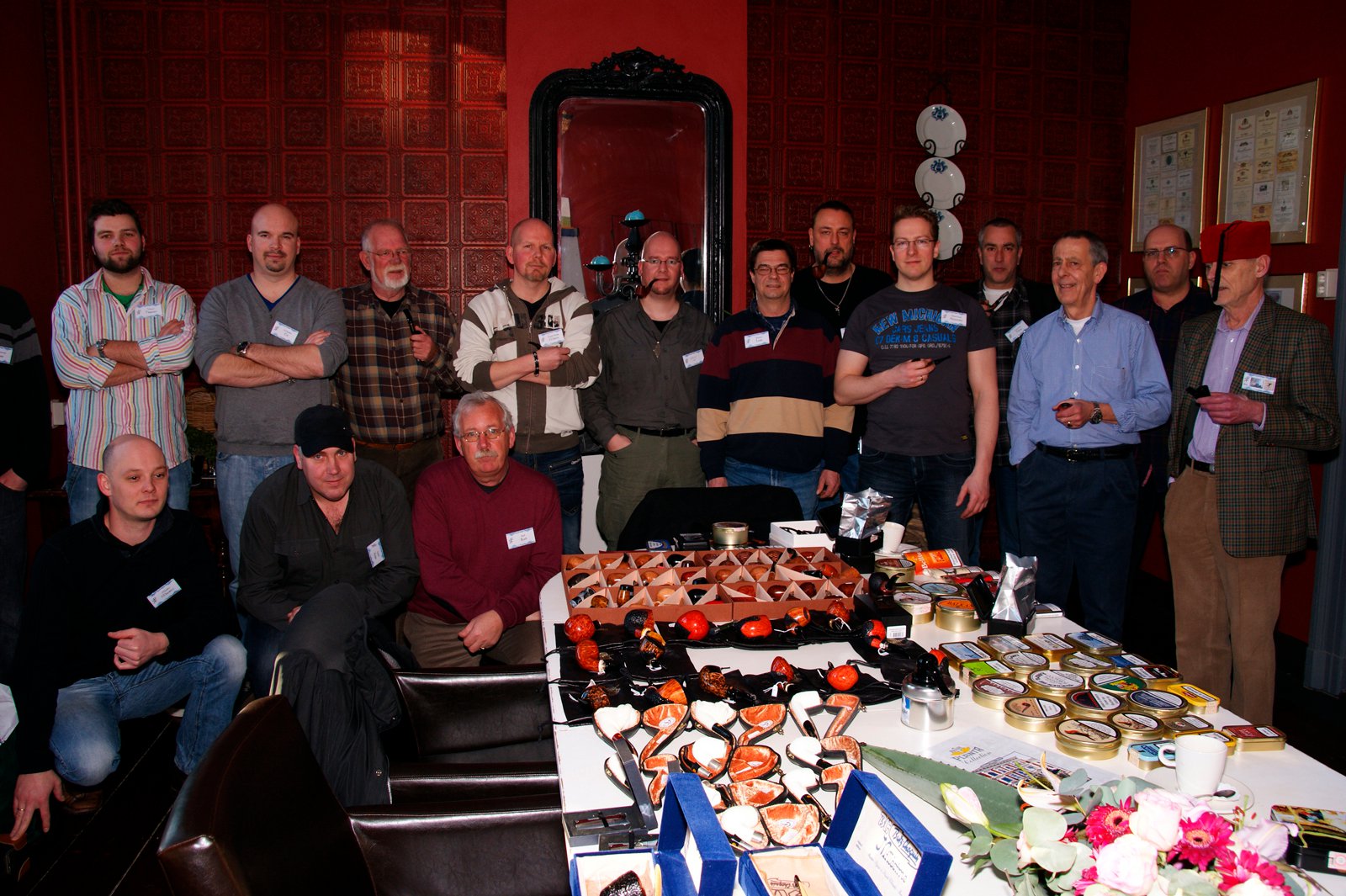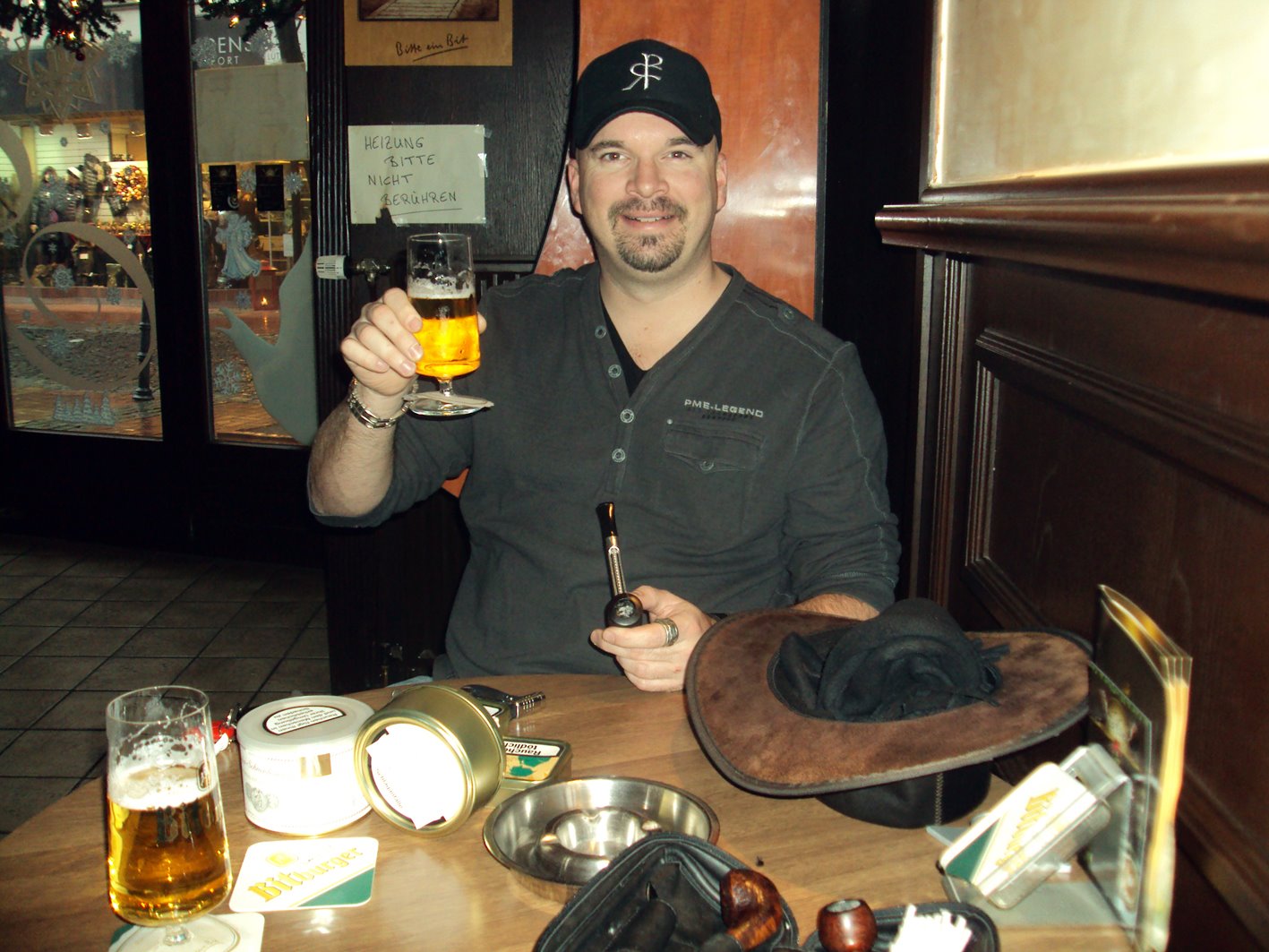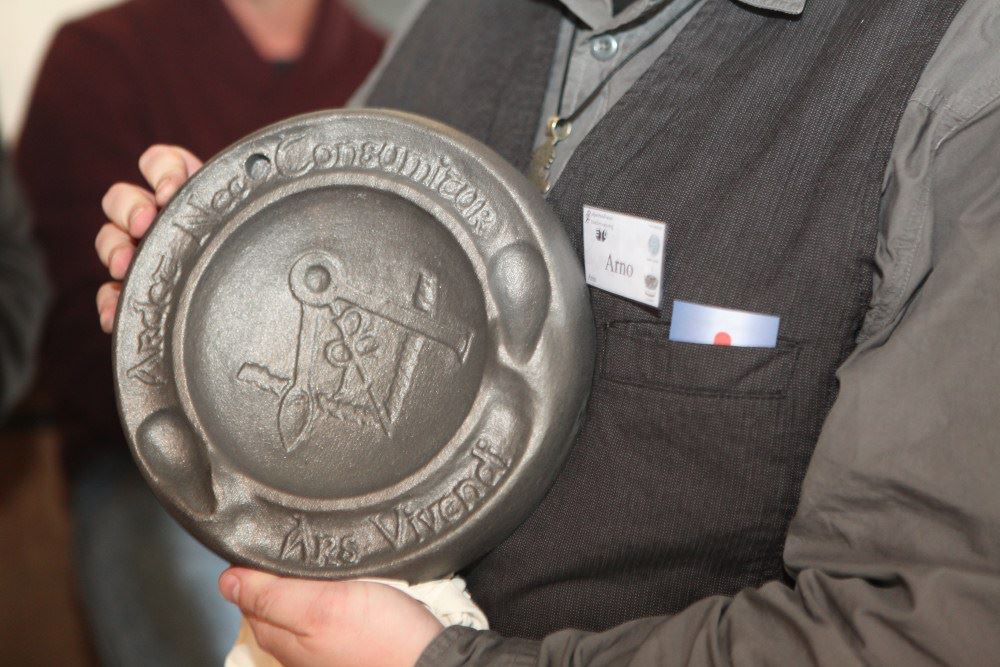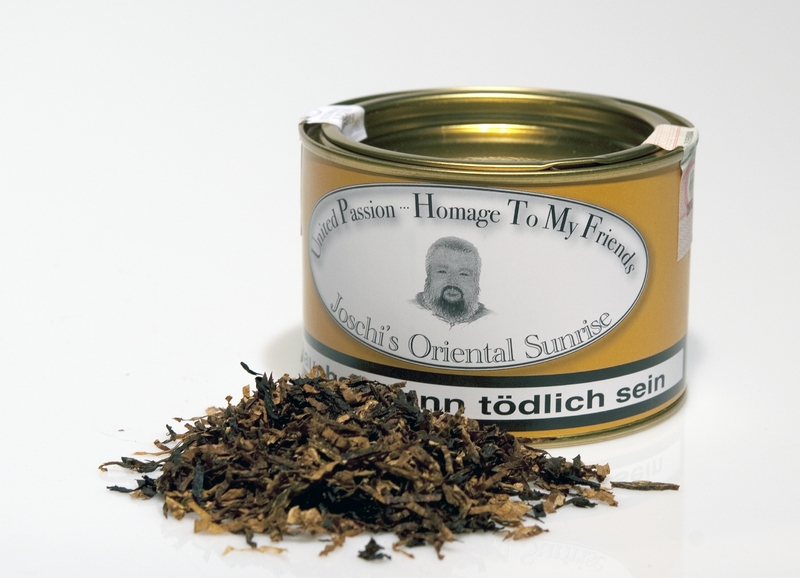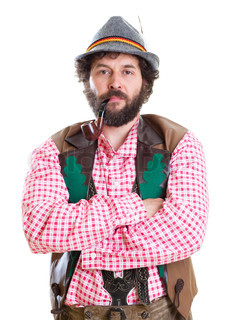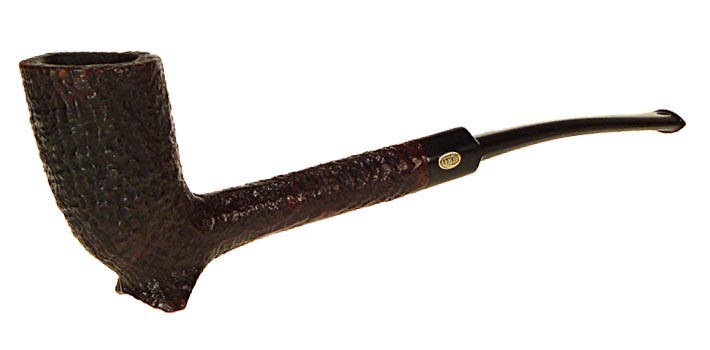Sometimes pictures say more than words. Amore, more, ore, re, nascuntur amicitiae.
Tag Archives: pipe smoking
Pleasures of life in Belgium 2014
Saturday 15 March it was time for the 2nd (for the first one, see here) annual Dutch/Belgian Pipe Smokers Forum meeting in Wuustwezel, Belgium. For weeks the forum had been buzzing with anticipation because it was going to be the biggest meeting yet. About 70 people were coming to the farm in the outskirts of the tiny town! Reason for this is, I think, because Wuustwezel is in Belgium but near the Dutch border. So it is very accessible for forum-members from both countries.
The day of the meeting I awoke early and after a shower and breakfast I started to pack, I had a long list of things to do.. My girlfriend Ellen had to laugh, she thought I behaved like I was going on a field trip. Well, it surely felt a bit that way. Around 10.15 the bell rang, it was Ed who was going to pick me up. After a cup of coffee we drove to Deventer Central Station where we were, once again, going to pick up Mark. For a change his train was on time, he was already waiting for us. We had one more member to pick up: Johnny (nickname: The Undertaker, after my favourite WWE wrestler). He had conveniently parked his car at a big parking place near the highway so with almost no delay he joined us and we could continue the journey to Belgium.
 With me I brought a bag of empty Belgian beer bottles so I could return them at a liquor store for their deposit. In Belgium alcohol is much cheaper then in The Netherlands (as is tobacco) and since my supply of Belgium beers was running dangerously low a visit to the local liquor store in Wuustwezel was mandatory. We were a bit early thanks to the lead foot of Ed so I had all the time to explore the immense store. Yes, immense! I have never seen a liquor store that big! Alcohol Valhalla! Whoohoo! After a bit of looking around we came to the section of the Belgian beers. In my head I had a list of them which included brands like St. Bernardus, Corsendonk, Chimay, Ciney, I’m getting thirsty now, Rochefort, Barbãr Bok, Kasteel Rouge and Julius. Happy as a child I filled my cart with bottles and went to the pay desk. €53 for the vast amount of beer I had put together was NOT much! In the Netherlands I surely would have paid around €100.. So that fact made this cheap Dutchman very happy.
With me I brought a bag of empty Belgian beer bottles so I could return them at a liquor store for their deposit. In Belgium alcohol is much cheaper then in The Netherlands (as is tobacco) and since my supply of Belgium beers was running dangerously low a visit to the local liquor store in Wuustwezel was mandatory. We were a bit early thanks to the lead foot of Ed so I had all the time to explore the immense store. Yes, immense! I have never seen a liquor store that big! Alcohol Valhalla! Whoohoo! After a bit of looking around we came to the section of the Belgian beers. In my head I had a list of them which included brands like St. Bernardus, Corsendonk, Chimay, Ciney, I’m getting thirsty now, Rochefort, Barbãr Bok, Kasteel Rouge and Julius. Happy as a child I filled my cart with bottles and went to the pay desk. €53 for the vast amount of beer I had put together was NOT much! In the Netherlands I surely would have paid around €100.. So that fact made this cheap Dutchman very happy.
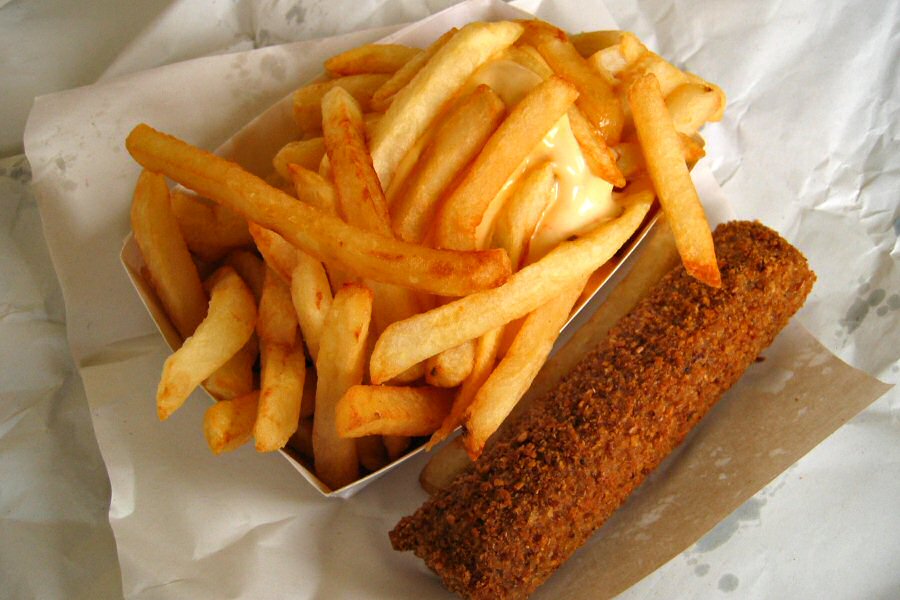 A lesson we learned from last year was that we had to have lunch before the meeting. Since Belgium is also famous for its fries (no not the skinny French fries but a somewhat thicker version) we decided to go to a snack-bar alongside the road. It was around 1 o’clock so we were the only customers. Most of us ordered fries and an extra snack, mine was a croquette. The friendly lady behind the desk asked if I wanted Belgian mayonnaise with my fries or Dutch. Hmm.. Belgian mayonnaise is sour and Dutch is sweet. I am bit ashamed to say this but I choose the Dutch mayonnaise. Usually when I am in a different country I adapt to the food that is being eaten there. But I really do not like sour mayonnaise.. Sorry!
A lesson we learned from last year was that we had to have lunch before the meeting. Since Belgium is also famous for its fries (no not the skinny French fries but a somewhat thicker version) we decided to go to a snack-bar alongside the road. It was around 1 o’clock so we were the only customers. Most of us ordered fries and an extra snack, mine was a croquette. The friendly lady behind the desk asked if I wanted Belgian mayonnaise with my fries or Dutch. Hmm.. Belgian mayonnaise is sour and Dutch is sweet. I am bit ashamed to say this but I choose the Dutch mayonnaise. Usually when I am in a different country I adapt to the food that is being eaten there. But I really do not like sour mayonnaise.. Sorry!
After we had filled our bellies it was finally time to go to the meeting. At the farm lots of cars were parked and when we did go inside the crowd already was large. First went to the table where Shaun and Jan were sitting. They were collecting the cash for the rent of the farm and the sausage rolls which would come in later. A new member, Willem (nickname: Meester W.), also stood at the table. We shook hands and I made a mental note to look him up later. Unfortunately he went away early, he had some other things to do so I never got the chance to really speak to him.
I wanted to place my bag with smoking gear and tobaccos somewhere so I could fill a pipe when I was stopped by Arjen (nickname: Bananabox-Ninja). In the months before the meeting he had arranged Missouri Meerschaum corncobs with the forum logo for forum-members. I had ordered a Country Gentleman together with some some black Danish bits which he gave to me. I tend to gnaw a bit on my mouthpieces so some spare bits were very welcome. But I also had something for him. Due to a sharp eye-tooth there was a hole in the mouthpiece of one of my GBD princes. Arjen learned a method from Steve from Reborn Pipes where you fill up holes like that with some kind of glue. I hope it works! (EDIT 15 May 2014: Arjen has done an incredible job with the mouthpiece and it looks like new!)
When I had put my bag away I finally could light up a pipe and talk to some people. I had some things for them and other people had things for me. Jorg tapped me on my shoulder, he had a generous sample of Davidoff Flake Medallions for me. I had never tried it but after having recently smoked a couple of bowls of it, it now is on my wanted list. Thanks Jorg! When I saw forum administrator Nick (nickname: Massis) we shook hands. He had a bouchon de Semois and asked if I still had those. No, I gave away my last one to Kevin, the owner of PipesMagazine.com. So he graciously gave me a bouchon. When I turned around Carro asked what I was holding. I answered it was a bouchon de Semois and explained how one should smoke it. Of course I gave it to him and got a pint of Vlaamse Leeuw beer in return. Then I bumped into Dre (nickname: Annie69) and he had a sealed tin of vintage De Graaff perique for me! A gift from a friend of him and fellow forum member Ignoro, who could not attend the meeting. So thanks Ignoro!
Near the sliding door at the corner of the room Paul had set up a small table with all kinds of whiskeys for everyone to sample. Very nice but I decided not to taste any of the “water of life”. That could not have turned out well for me in combination with the heavy Belgium beers. Once in a while Paul orders at Dan Tobacco in Germany and people of the forum can add their wishes to his list. So that way I ordered a tin of Skipper’s Flake through him only to discover that he bought a tin of Skipper Special Navy Cut Mellow Mixture instead. Whoops! Luckily I did not have to pay for that tin and on top of that, as a surprise, he gave me a tin of… Skipper’s Flake! Thank you Paul!
In the distance I spotted Klaas (nickname: Upper Ten), I still had his forum-tobaccos. “Keep them until the Wuustwezel meeting, that saves me the postal costs.” He said. “I have enough tobaccos in my treasure chamber to go by”. Which is true, he really has a tobacco treasure chamber. For years Klaas invested in his tobacco collection by buying brands like Upper Ten (hence his nickname), De Graaff (the famous house-blends of the De Graaff store in The Hague) and Balkan Sobranie. The first time I smoked that legendary blend it was from a pouch which he gave me. Klaas has a fondness for latakia so I had a sample of GL pease Gaslight for him. It has a kind of cigar-like heaviness which could be just Klaas his cup of tea. I also gave him a sample of Heinrichs Curly Block. At my visit to Heinrichs I bought a tin of Dunhill Deluxe Navy Rolls for him because he wanted an impression of the taste of current production Escudo. He did not like it very much, in his memory the old Cope Escudo version was way better. Unfortunately he did not stock up on that one.. But according to lots of German pipe-smokers the Curly Block is similar to the Cope Escudo. So I am curious what Klaas thinks of this tobacco.
At the meeting there were lots of new members who had never attended such an event. Geoff was one of them. He approached me and said he was a fan of this blog, how nice! Normally I am having a hard with speaking to people I do not know, but with pipe-smokers you always have something to talk about: pipe-smoking! Duh! He said he had an avatar of a smoking monkey but that did not shone a light in my brain. It was not until later, back home, that I saw him on the forum. Ahh!! The smoking monkey avatar! It was nice talking to you Geoff! Another new member, Rinus, asked me if I was the one who knew a lot of tobaccos. Well.. I do not know a lot, but I do know something. Rinus discovered he had a fondness for latakia. He was missing something in the blends he bought and found out that was the dark leaf. So I made a list for him with mixtures containing latakia that are available in The Netherlands. I hope he finds something he likes.
Then I had something special. I approached Martin and asked if he could help opening a 90-year old tin of Capstan Navy Flake. Well, he is an old Dutch marine man so if someone could do that job, it was him. I grabbed my camera and just at the moment Martin pierced through the foil of the knife-cutter tin my battery died.. Arghh!! Luckily Martin was able to make some pictures with his smartphone. But those will be for a another blog-post. Astoundingly the condition of the tobacco inside the tin was perfect! I had brought a mason jar with me and quickly transferred the contents. In the mean time Dwayne had joined Martin and me. He his an American pipe-maker who now lives in The Netherlands and was also amazed about the vintage Capstan. Needless to say both could fill up their pipes with this old treasure.
When ordering a beer at he bar I saw Tommy. We had e-mailed a couple of times before because one of his hobbies is to sing and write lyrics for songs. Only, he can’t make the music that would go with those so he asked on the forum if someone could help him with that. I have made music for years so I definitely was interested. When singing Tommy has a warm, baritone voice that resembles the one of Dutch artist Ramses Shaffy. What followed was an animated conversation about our passion for music. When I have the time I will definitely try to make some music to match the lyrics.
After dinner, which existed once again of the delicious Belgian sausage rolls, I sat down. My feet were hurting from standing and walking around. I already talked to so many people. I joined a group who was talking about buying tobacco abroad, which I frequently do. The big man next to me said if he could get all the tobaccos he wanted in The Netherlands he would buy them there. An honest opinion. I detected a strange accent in his soft voice and asked if had lived abroad for a period of time. Franz (that is his name, nickname: Dinck) told me he was born in Buenos Aires, Argentina, but already lived for quite some time in The Netherlands. While talking my eye suddenly went to his pipe-bag. With a smile he took a couple of pipes out of it. All of them were made in England. It appeared we both had a passion for English pipes. Only, I (try to) collect Dunhills, he collected everything but Dunhill. He pulled out a Sasieni prince which made me drool. Immediately I, quasi joking, asked for how much I could buy it from him. Of course it was not for sale. Damnit! I hope it brings him great smoking pleasure.
Too fast the hours crawled away, when you are having fun time always goes (too) fast. Hora ruit tempus fluit! So the time came to say goodbye. We thanked Jan, his wife Sas and Dirk and Miep who had stood behind the bar the whole day. The journey back went swiftly and before I knew it I stood before Ellen, who had fallen asleep on the couch and slowly woke up. “How was your day?” “It was wonderful darling.”
Big thanks to Ed for driving, to Johnny and Mark for the conversations in the car, to Jan and Sas for the organisation and everyone I talked to! I can’t remember who took which photo so all pictures from the meeting were made by Klaas, Janneman, Dirk, Mark, Rik and myself.
One Thousand and One Smoky Nights
 I always had a love for the Middle East; the pyramids and temples near Cairo, the ancient city of Damascus, the holy places in Jerusalem, the heart of the Ottoman empire Constantinople (Istanbul), mysterious Baghdad and the Muslim centre of Mecca. They all fascinate me to no extent. When I walked through the busy streets of the grand Khan el-Khalili bazaar in Cairo I knew I had to visit more places like that. Unfortunately, just as I was making plans to visit Damascus all hell broke loose with the still ongoing Syrian Civil War.
I always had a love for the Middle East; the pyramids and temples near Cairo, the ancient city of Damascus, the holy places in Jerusalem, the heart of the Ottoman empire Constantinople (Istanbul), mysterious Baghdad and the Muslim centre of Mecca. They all fascinate me to no extent. When I walked through the busy streets of the grand Khan el-Khalili bazaar in Cairo I knew I had to visit more places like that. Unfortunately, just as I was making plans to visit Damascus all hell broke loose with the still ongoing Syrian Civil War.
Talking about Syria, at the beginning of this year I received an e-mail from a Syrian-American named Kai. He had moved to Rotterdam last year for work (he is an architect) and he just got back to pipe smoking after taking a break for a while. Kai used to smoke Mac Baren HH Vintage Syrian in the USA and asked if he could get that blend in The Netherlands. I had to disappoint him but gave some tips where he would be able to buy it. We kept on mailing and I discovered that he was born in the Syrian port-city of Latakia. A word well known by us pipe-smokers because of the fire-cured dark leaf with the same name. Kai then was raised in Damascus until he moved to the USA just a few years before the civil war broke loose. Smoking the HH Vintage Syrian is his way to relate to his roots. Sadly his visa was not renewed by the Dutch government, which pissed me off pretty much, so now he is moving back to the States. But I promised Kai not to say anything about his situation in this blog. His dad always said, don’t get near two things in life: politics and drugs. A wise man. So Kai, this one is for you, enjoy the read.
 According to an 18th century belief tobacco did not originate exclusively from the Americas but was also domestic in various parts of Asia and Africa. It was also believed that people in the Middle East used tobacco before my ancestors gazed upon the New World. However, since the 19th century the prevailing opinion has been that the Old World, including the Middle East, was introduced to tobacco by the early European discoverers.
According to an 18th century belief tobacco did not originate exclusively from the Americas but was also domestic in various parts of Asia and Africa. It was also believed that people in the Middle East used tobacco before my ancestors gazed upon the New World. However, since the 19th century the prevailing opinion has been that the Old World, including the Middle East, was introduced to tobacco by the early European discoverers.
 Tobacco first arrived in the Ottoman Middle East at the end of the 16th century. Which is about 100 years after its introduction in Europe. At the beginning of the 17th century Portuguese and other European sailors, who travelled around the Indian Ocean within the Red Sea and Persian Gulf, introduced smoking to the Arabian Peninsula. Perhaps even as early as 1590 to Yemen and the Hijaz. 10 years earlier than tobacco’s introduction into Yemen it was brought to Constantinople by English sailors and traders who personally used tobacco.
Tobacco first arrived in the Ottoman Middle East at the end of the 16th century. Which is about 100 years after its introduction in Europe. At the beginning of the 17th century Portuguese and other European sailors, who travelled around the Indian Ocean within the Red Sea and Persian Gulf, introduced smoking to the Arabian Peninsula. Perhaps even as early as 1590 to Yemen and the Hijaz. 10 years earlier than tobacco’s introduction into Yemen it was brought to Constantinople by English sailors and traders who personally used tobacco.
At first tobacco mainly was the interest of physicians and appeared in medical manuals by the end of the 16th century. Its leaves were prescribed as a remedy for bites and burns. Soon after that, in the early years of the 17th century, tobacco also began to be smoked recreationally. In the first decades of the 17th century tobacco already was smoked openly in places where people gathered like markets and streets. These early smokers were probably townspeople who could have more readily afforded the expensive import from America and the Caribbean. A lot of those imported tobaccos came through the Syrian port of Latakia. However, by 1700 the Ottoman market was producing most of its own tobacco because, of course, regional merchants had noticed the demand. Local varieties allowed for the consumption of tobacco to become a pleasurable pastime for people from all levels of society (men AND women! Well, at least in the private sphere..) and the one constant was that it was certainly in high demand.
 Later a number of regions within the empire became centres for tobacco production and distribution. Varieties of Indian, Syrian, Iraqi and Persian tobacco were imported and smoked in the Arabian towns. Local varieties of tobacco, known as tittun or dokhân were also cultivated and widely consumed within Arabia. Tobacco also was grown in Macedonia, Anatolia, northern Syria (particularly in the hills around the port of Latakia I mentioned before) and after some time in Lebanon and Palestine. Persian and Kurdish varieties, known locally as tunbak, were also prized but were mostly used in water pipes (hookah). This is correct because I asked Kai if he already smoked pipe in Syria. He answered that he did not smoke the tobacco-pipe, but made use of the water pipe. Only, he didn’t smoke the typical ultra-aromatic mu‘assel we associate with the hookah but used tunbak, which is a natural tobacco.
Later a number of regions within the empire became centres for tobacco production and distribution. Varieties of Indian, Syrian, Iraqi and Persian tobacco were imported and smoked in the Arabian towns. Local varieties of tobacco, known as tittun or dokhân were also cultivated and widely consumed within Arabia. Tobacco also was grown in Macedonia, Anatolia, northern Syria (particularly in the hills around the port of Latakia I mentioned before) and after some time in Lebanon and Palestine. Persian and Kurdish varieties, known locally as tunbak, were also prized but were mostly used in water pipes (hookah). This is correct because I asked Kai if he already smoked pipe in Syria. He answered that he did not smoke the tobacco-pipe, but made use of the water pipe. Only, he didn’t smoke the typical ultra-aromatic mu‘assel we associate with the hookah but used tunbak, which is a natural tobacco.
 It was not easy for Middle Easterners to smoke tobacco for quite some time. That was made clear by the number of Islamic fatwas expressed by the Ottoman administration towards the lawfulness of smoking. This because tobacco was not known at the time of the Prophet, it is not named in the Qur’an. Which resulted in a debate over its legality to spread throughout the empire. The main question in debates was “if the consumption of tobacco was harmful to the user and his or her surroundings”. Islamic scholars interpreted general guidelines stated in the Qur’an or the hadith to support their arguments for or against its use. Soon after the rise in popularity of tobacco the religious authorities in Mecca grouped it with wine, opium and coffee. Thus issuing a fatwa banning it as an intoxicant.
It was not easy for Middle Easterners to smoke tobacco for quite some time. That was made clear by the number of Islamic fatwas expressed by the Ottoman administration towards the lawfulness of smoking. This because tobacco was not known at the time of the Prophet, it is not named in the Qur’an. Which resulted in a debate over its legality to spread throughout the empire. The main question in debates was “if the consumption of tobacco was harmful to the user and his or her surroundings”. Islamic scholars interpreted general guidelines stated in the Qur’an or the hadith to support their arguments for or against its use. Soon after the rise in popularity of tobacco the religious authorities in Mecca grouped it with wine, opium and coffee. Thus issuing a fatwa banning it as an intoxicant.
 Not only was the debate over the consumption of tobacco religious, but also political. As early as 1610 an English traveller wrote about seeing “an unfortunate Turk riding about the streets of Constantinople….. Mounted backward on a donkey with a tobacco-pipe driven through the cartilage of his nose. Just for the crime of smoking”. I sometimes feel we are close to such a situation in our modern times.. Two years later, Sultan Ahmed I issued a temporary ban on smoking. In 1631, Murad IV began a campaign against the consumption of tobacco and outlawed its cultivation in the empire, but this failed. In 1633, after a devastating fire in Constantinople, Murad IV outright forbade tobacco consumption and inflicted severe punishment on smokers. During this time of smoking prohibition many people preferred to use crushed tobacco (snuff) to avoid being caught with a pipe. Murad IV also banned coffee and ordered the closure of coffee-houses, where both coffee and tobacco were consumed. What a horrible man..
Not only was the debate over the consumption of tobacco religious, but also political. As early as 1610 an English traveller wrote about seeing “an unfortunate Turk riding about the streets of Constantinople….. Mounted backward on a donkey with a tobacco-pipe driven through the cartilage of his nose. Just for the crime of smoking”. I sometimes feel we are close to such a situation in our modern times.. Two years later, Sultan Ahmed I issued a temporary ban on smoking. In 1631, Murad IV began a campaign against the consumption of tobacco and outlawed its cultivation in the empire, but this failed. In 1633, after a devastating fire in Constantinople, Murad IV outright forbade tobacco consumption and inflicted severe punishment on smokers. During this time of smoking prohibition many people preferred to use crushed tobacco (snuff) to avoid being caught with a pipe. Murad IV also banned coffee and ordered the closure of coffee-houses, where both coffee and tobacco were consumed. What a horrible man..
 Fortunately the bans by Murad IV and others before him did not produce the desired results. Thus proving that coffee and tobacco consumption were already well rooted within the 17th century Middle East. In other words, smoking was not eradicated during these prohibitions. In 1646, during the reign of Ibrahim, the Turkish government issued a decree allowing for the consumption of tobacco. The religious legalization of smoking was granted in a fatwa issued in the early years of the 1720’s by Damascene Islamic scholar Abd al-Ghani al-Nabulsi. He wrote an essay entitled (I hope I type this correctly) “al Sulh bayna al-ikhwan fi hukm ibahat al-dukhkhan” which translates as “Peace Among Friends Concerning the Legalization of Smoking”. Al Nabulsi’s position on the consumption of tobacco was that smoking is like food. If it hurts stop it, if it does not, then why not smoke? Brilliant. The question regarding tobacco’s harmfulness remained a controversial issue for centuries to come. As it still is today. Nonetheless, it was not until the 18th century that tobacco consumption became a legitimate social pastime practice as was illustrated in many coffee-house illustrations of that time and later.
Fortunately the bans by Murad IV and others before him did not produce the desired results. Thus proving that coffee and tobacco consumption were already well rooted within the 17th century Middle East. In other words, smoking was not eradicated during these prohibitions. In 1646, during the reign of Ibrahim, the Turkish government issued a decree allowing for the consumption of tobacco. The religious legalization of smoking was granted in a fatwa issued in the early years of the 1720’s by Damascene Islamic scholar Abd al-Ghani al-Nabulsi. He wrote an essay entitled (I hope I type this correctly) “al Sulh bayna al-ikhwan fi hukm ibahat al-dukhkhan” which translates as “Peace Among Friends Concerning the Legalization of Smoking”. Al Nabulsi’s position on the consumption of tobacco was that smoking is like food. If it hurts stop it, if it does not, then why not smoke? Brilliant. The question regarding tobacco’s harmfulness remained a controversial issue for centuries to come. As it still is today. Nonetheless, it was not until the 18th century that tobacco consumption became a legitimate social pastime practice as was illustrated in many coffee-house illustrations of that time and later.
 From the late 17th century onwards the tobacco pipe became a highly personalized possession in Arabia. With ornamented varieties coming from pipe-maker guilds in Turkey, England, France, Greece, Egypt, Palestine, and Lebanon. Probably every town of any size had at least one pipe-maker. Even potters in villages could turn out a few pipes from moulds brought from bigger cities. A lot of pipes were also produced in Mecca and Medina as smoking was popular in the heart of Arabia. Even the Sharif of Mecca engaged in tobacco consumption: “He sat upright on his divan, like an European, and smoked tobacco in a pipe like the “old Turks”. The simple earth-made bowl was set in a saucer before him, it’s white jasmine stem was almost a spear’s length.” Clay pipes were a preferable means for consuming tobacco. They were very portable and therefore more convenient to the highly mobile consumer (such as a pilgrim making the hajj). Furthermore clay tobacco pipes were readily available in any market and to customers from all levels of society.
From the late 17th century onwards the tobacco pipe became a highly personalized possession in Arabia. With ornamented varieties coming from pipe-maker guilds in Turkey, England, France, Greece, Egypt, Palestine, and Lebanon. Probably every town of any size had at least one pipe-maker. Even potters in villages could turn out a few pipes from moulds brought from bigger cities. A lot of pipes were also produced in Mecca and Medina as smoking was popular in the heart of Arabia. Even the Sharif of Mecca engaged in tobacco consumption: “He sat upright on his divan, like an European, and smoked tobacco in a pipe like the “old Turks”. The simple earth-made bowl was set in a saucer before him, it’s white jasmine stem was almost a spear’s length.” Clay pipes were a preferable means for consuming tobacco. They were very portable and therefore more convenient to the highly mobile consumer (such as a pilgrim making the hajj). Furthermore clay tobacco pipes were readily available in any market and to customers from all levels of society.
In the early 17th century two ways of smoking existed: “with water” or “dry”. But (of course) smoking tobacco through a dry pipe was superior to the water method. Which was done through the hookahs I mentioned earlier or narghiles, Middle Eastern innovations. The main device associated with tobacco consumption in the Arabian provinces was the oriental pipe, referred to in Turkish as the chibouk (Arabic: shibuk). The English-style kaolin pipes were likely to be more influential to styles in Istanbul, the imperial centre of the empire, where tobacco and the English pipes reached Turkey by the harbour. The 3-part chibouk arrived from North Africa in the Middle East and was readily adopted as the main instrument for smoking tobacco in the early 17th century. The chibouk consists of three elements: the head or bowl (Turkish: lüle), the stem and the mouthpiece. The bowls were made from a variety of materials including wood, stone, meerschaum or even metal. But the common material was clay. The stems were made of various woods or reeds and ranged in length from about 1 meter to 4 (!) meters. The mouthpieces were usually made of amber but could also be made of coral, gold and enamel. Precious stones could be added according to the taste and purse of the purchaser.
 Climatic and cultural differences led to the development of two different types of pipes in Europe and the Ottoman Middle East. The hot weather in much of the Middle East created a preference for the inhalation of “cold smoke” while in the cooler weather of Europe smokers preferred “hot smoke”. Well, a moderate hot smoke of course. The technical solution to this issue of cooling the smoke within a dry pipe resulted in the 3-part style of the chibouk. For instance, the longer stem length allows the smoke to cool before it reaches the smoker. Wet silk was often applied to cover the stem to even increase its cooling capabilities. The longer stems, up to the 4 meters I mentioned before, were preferred in the hotter climes of the southern portions of the empire. Shorter stems, 20 centimetres to 1 meter, were used in the more northern, cooler climates. The varying lengths of stems are portrayed in numerous illustrations from the 18th and 19th centuries.
Climatic and cultural differences led to the development of two different types of pipes in Europe and the Ottoman Middle East. The hot weather in much of the Middle East created a preference for the inhalation of “cold smoke” while in the cooler weather of Europe smokers preferred “hot smoke”. Well, a moderate hot smoke of course. The technical solution to this issue of cooling the smoke within a dry pipe resulted in the 3-part style of the chibouk. For instance, the longer stem length allows the smoke to cool before it reaches the smoker. Wet silk was often applied to cover the stem to even increase its cooling capabilities. The longer stems, up to the 4 meters I mentioned before, were preferred in the hotter climes of the southern portions of the empire. Shorter stems, 20 centimetres to 1 meter, were used in the more northern, cooler climates. The varying lengths of stems are portrayed in numerous illustrations from the 18th and 19th centuries.
 Today, tobacco is cultivated and cigarettes are manufactured in parts of the Middle East, North Africa and Muslim Asia. But only Turkey ranks among the world’s top 10 tobacco-producing countries. Though many reports claimed that the people of Persia and the Ottoman Empire consumed vast amounts of tobacco, actual consumption seems to have been less than in most parts of Europe. These days the tobacco consumption in Middle Eastern countries is only about one half of that in the West. In many countries most people used to smoke cheap, locally produced tobacco. Now more expensive import brands are popular almost everywhere. Either directly imported or manufactured under licence. Such a shame because it were the locally produced (oriental) tobacco gems that fascinated us pipe-smokers. As-salāmu ʿalaykum!
Today, tobacco is cultivated and cigarettes are manufactured in parts of the Middle East, North Africa and Muslim Asia. But only Turkey ranks among the world’s top 10 tobacco-producing countries. Though many reports claimed that the people of Persia and the Ottoman Empire consumed vast amounts of tobacco, actual consumption seems to have been less than in most parts of Europe. These days the tobacco consumption in Middle Eastern countries is only about one half of that in the West. In many countries most people used to smoke cheap, locally produced tobacco. Now more expensive import brands are popular almost everywhere. Either directly imported or manufactured under licence. Such a shame because it were the locally produced (oriental) tobacco gems that fascinated us pipe-smokers. As-salāmu ʿalaykum!
Dutch Clay Pipes
Windmills, tulips, wooden-shoes, cheese, weed and red light districts are all things which are typical Dutch. What is also quintessential Dutch is the clay pipe. In my blogpost Dutch Tobacco Trade I already told that in the 17th century smoking became more and more common in The Netherlands. Since the modern day cigar and cigarette had not been invented yet there was no smoking without pipes.
 In the second half of the 16th century pottery makers in England succeeded in making usable pipes from clay. Especially English places like Winchester, Bristol, Chester, Hull and London seemed to have played an important role in the development of the clay pipe as an instrument of smoking. Contacts between England and the Dutch Republic did go over water at the end of the 16th century. That is why the Dutch harbours first came into contact with tobacco. This image is confirmed by archaeological discoveries.
In the second half of the 16th century pottery makers in England succeeded in making usable pipes from clay. Especially English places like Winchester, Bristol, Chester, Hull and London seemed to have played an important role in the development of the clay pipe as an instrument of smoking. Contacts between England and the Dutch Republic did go over water at the end of the 16th century. That is why the Dutch harbours first came into contact with tobacco. This image is confirmed by archaeological discoveries.
At the beginning of the 17th century the Dutch Republic fought out the 80-years’ war with Roman-Catholic Spain. Many English mercenaries fought in the army of Maurits. When in 1609 the 12 years’ truce was announced a lot of English soldiers became unemployed. Many of them resorted to the profession they executed in England. Also because of James I many English pipe makers fled to my country. This had two reasons, first James I was known for his disgust of tobacco, of which his son was addicted to. In a writing called “A Counter Blast to Tobacco” he pointed out the dangers of tobacco to his subjects (today this is still being done by many governments). Second he prosecuted puritans because of their faith. It were the humble craftsmen like pipe-makers and weavers that belonged to this group. So they fled to the liberal Netherlands and continued their craft here. This way they introduced the smoking of a pipe in the Dutch Republic and more important, they taught the local inhabitants how to make clay pipes.
 Around 1610 the first pipe-production slowly starts in Amsterdam and Leiden, nothing more than little companies in the domestic circle. It was necessary that the whole family helped in order to make enough money for a frugal meal. In the next decade the industry will spread to places like Gouda, Enkhuizen, Rotterdam, Delft and Schoonhoven. After this the craft expanses further across the country to Zwolle, Deventer and Middelburg until around 1640 there are also pipe-makers situated in Groningen and Maastricht. But the most well known place was and still is Gouda.
Around 1610 the first pipe-production slowly starts in Amsterdam and Leiden, nothing more than little companies in the domestic circle. It was necessary that the whole family helped in order to make enough money for a frugal meal. In the next decade the industry will spread to places like Gouda, Enkhuizen, Rotterdam, Delft and Schoonhoven. After this the craft expanses further across the country to Zwolle, Deventer and Middelburg until around 1640 there are also pipe-makers situated in Groningen and Maastricht. But the most well known place was and still is Gouda.
The first English pipe-maker who arrived in Gouda, having fled England because of his faith, was William Baernelts in 1608. He declared he was born in Bromyard (near Stratford) and that his profession was stonecutter. In 1617 William started with the craft of pipe-maker. Until 1637 it were the English pipe-makers who had the lead. It was not until 1640 that the Gouda pipe-makers surpassed the English. Around 1640 the Gouda pipe-makers filed a permission to establish a guild which excluded their English colleagues. In 1665 this guild had 180 members and in 1666 the first Gouda pipe-market was held. After that the fabrication of pipes in Gouda really took off. In 1749 there were 349 pipe-factories and half of the Gouda inhabitants had a job in those. Also the area of distribution was no longer limited to the region or the country. Today Dutch clay pipes are still found around the world.
The shape of the pipes changed during the years. The walls of the bowl and the mouthpiece of the clay pipe became thinner because of better clay and an improved method of fabrication. The bowl also got bigger because the price of tobacco went down. Wished that was still the case! In the early years the pipes were short and pretty hot to smoke. Therefore the mouthpiece became longer and the pipe became more pleasant to smoke. Each pipe had certain trademarks that were registered with the result that today it is still possible to track who made the pipe and when it was made. We can distinguish these trademarks in heel-marks, bowl-marks and mouthpiece-marks.
Heel-marks: When the skills of the pipe-makers grew and the market appreciated more quality a need rose to label the pipes with an unique trademark. In the first instance it often was a simple figure applied to the bottom of the heel of the pipe. Later real stamps were developed with the initials of the pipe-maker or images of for example a rose or scales. Soon a kind of brand-loyalty arose from pipe-merchants and pipe-smokers. Some wanted trademarks were swiftly rented, sold or counterfeited. Therefore the official guilds (especially in Gouda and Amsterdam) kept a registration of trademarks and the owners of those. A representative of the guild regularly checked if pipe-makers did not make themselves guilty of counterfeiting trademarks that belonged to a colleague.
Bowl-marks: This way of decoration roughly took place in the period from 1725 to 1825. Especially the rose proved to be very popular during the years. Commonly these decorations were not applied to more expensive pipes because the relief made the polishing very difficult.
Mouthpiece-marks: This kind of decoration is pretty rare. Imagine the price a silversmith would ask for making the moulds! But despite the numbers are small, the variety is surprisingly big. The mouthpiece was used to display names but there are also examples of real commercial messages. Flower and animal figures were also common. A practical advantage of these pipes were that they offered a better grip because they were less smooth . Typical of the in Hoorn produced pipes of this type was the usage of green or brown lead-glaze as an extra decoration.
The manufacturing process of a clay pipe consists of a number of steps:
 1. From England, Cologne, Liège or Rouen white-baking clay is imported. This clay undergoes a number of specific treatments (removal of contaminations, grinding, laid to rest (in Dutch this is called “zoken”)) before it is suitable for further processing.
1. From England, Cologne, Liège or Rouen white-baking clay is imported. This clay undergoes a number of specific treatments (removal of contaminations, grinding, laid to rest (in Dutch this is called “zoken”)) before it is suitable for further processing.
 2. By hand the pipe-maker rolls the correct amount of clay to a strand of the right thickness with a kind of lump at the end. In such a way that it fits the pipe-mould. After several days of stiffening the semi-finished product is ready for the next step in the process.
2. By hand the pipe-maker rolls the correct amount of clay to a strand of the right thickness with a kind of lump at the end. In such a way that it fits the pipe-mould. After several days of stiffening the semi-finished product is ready for the next step in the process.
 3. The pipe-maker creates the smoking channel in the mouthpiece of the pipe with a so called “weijer” (from the English “wire”), an iron needle or pin. The pin is not stuck in the clay, but the clay is pushed over the pin. Before all this sewing machine oil is applied on the weijer.
3. The pipe-maker creates the smoking channel in the mouthpiece of the pipe with a so called “weijer” (from the English “wire”), an iron needle or pin. The pin is not stuck in the clay, but the clay is pushed over the pin. Before all this sewing machine oil is applied on the weijer.
 4. The roughly shaped pipe is put into an oil-greased pipe-mould which is shut and placed in a bench-vice. Simultaneously with the tightening of the bench-vice the clay of the bowl is pressed.
4. The roughly shaped pipe is put into an oil-greased pipe-mould which is shut and placed in a bench-vice. Simultaneously with the tightening of the bench-vice the clay of the bowl is pressed.
 5. A conical metal shape (“stopper”) is driven again and again in the opening of the pipe-mould to shape the bowl. The stopper is also greased before usage.
5. A conical metal shape (“stopper”) is driven again and again in the opening of the pipe-mould to shape the bowl. The stopper is also greased before usage.
 6. The pipe-mould is opened and the pipe is lifted out carefully. Excess clay is scraped of the seams of the mouthpiece and the weijer is put out slowly. After the pipes have dried somewhat and feel a little more solid the upper-edges of the bowl and the mouthpiece a trimmed with a sharp knife. If necessary a trademark is applied on the pipe. Luxury pipes are also polished.
6. The pipe-mould is opened and the pipe is lifted out carefully. Excess clay is scraped of the seams of the mouthpiece and the weijer is put out slowly. After the pipes have dried somewhat and feel a little more solid the upper-edges of the bowl and the mouthpiece a trimmed with a sharp knife. If necessary a trademark is applied on the pipe. Luxury pipes are also polished.
 7. After a week of drying the pipes go into the oven and are baked by a maximum temperature of 1050ºC. After that they can be glazed and/or painted if wanted after which baking is necessary again. In the past baking primarily took place at potters because they had the knowledge and expensive ovens.
7. After a week of drying the pipes go into the oven and are baked by a maximum temperature of 1050ºC. After that they can be glazed and/or painted if wanted after which baking is necessary again. In the past baking primarily took place at potters because they had the knowledge and expensive ovens.
One of the big names in the fabrication of clay pipes is the Goedewaagen company. On January 1th 1779 Dirk Goedewaagen passed his master-test for pipe-maker and in February his first assistant came into service. At first the pipe-factory was situated in the Keizerstraat in Gouda but grandson Abraham Goedewaagen relocated the company to the Gouwe, also in Gouda. His sons Pieter and Tobias Goedewaagen took over the “De Star” pottery which dates from 1610. To get more profit and to let the company expand Pieter decided to orientate on the Belgian and French market.
Around 1874 and 1882 son Aart persuades his father Pieter to set up a broader, more internationally orientated assortment. Many mould-shapes are took over from Belgian and French pipe factories. After no less then 10 years the company possesses over hundreds of pipe-models. Because of this vast assortment the Goedewaagen pipe-factory surpassed all the other Gouda companies. The P. Goedewaagen & Zoon firm manages to expand and hold its position in The Netherlands. The sales to Belgium and France also went very well. Through English warehouses the company gets lots of orders for the shipping of pipes to countries in Africa. After WWII the demand for pipes declines and the firm concentrates on the manufacturing of pottery. In the beginning of the 1980’s the company comes into financial troubles which leads to their bankruptcy in 1982. Today the name has changed to Royal Goedewaagen and pottery and the occasional souvenir clay pipe is still being made.
Another big name is Zenith. The history of this company starts in 1749 when Pieter van der Want passes his master-test for pipe-maker for the Gouda pipe-guild. Thus starting a line of pipe-manufacturers that from father to son will exist for 8 generations. From the 1950’s Zenith has the oldest, still functioning pipe-factory in the world. Chacom from Saint-Claude stands second with a founding year of 1780. Zenith is well known for a couple of innovations of the clay pipe. Instead of pressing the pipes in metal press-moulds these pipe are being made by pouring clay in moulds made of plaster. The baked pipes were then covered with a glaze layer which gave the pipe a solid, tight and glossy look.
In the 1920’s the product is perfected further. The so called “hollow bowl system” is introduced. The bowl is fit with an inner bowl with a hollow space between both walls. In this space the smoke can circulate, cool off and in the meantime yield its moisture to the ceramic. Thanks to this cooling system the Zenith pipe soon becomes the ultimate dry-smoker. Another innovation is the co called “doorroker”. From its introduction shortly after 1900 it was popular with millions of smokers. After smoking it for a while an image appears on the pipe that stands in contrast with the darkening bowl. That is why the doorroker is also known as the mystery pipe. But also the Zenith Van Der Want company does not survive and closes its doors in 1984.
 The decline of the pipe-industry, which began in the 19th century, picks up more speed in the 20th century because of the fashion of the smoking of cigars and cigarettes. When the modern day cigarette was introduced and pipes of briar smoked better and proved to be not so vulnerable it soon was over for the clay pipe. The little simple pipe is now being used by children to blow bubbles with and the beautifully decorated ones stand as an art-object in an antique pipe-rack. The pipes are also being sold as souvenirs and are being used in historical reenactment events.
The decline of the pipe-industry, which began in the 19th century, picks up more speed in the 20th century because of the fashion of the smoking of cigars and cigarettes. When the modern day cigarette was introduced and pipes of briar smoked better and proved to be not so vulnerable it soon was over for the clay pipe. The little simple pipe is now being used by children to blow bubbles with and the beautifully decorated ones stand as an art-object in an antique pipe-rack. The pipes are also being sold as souvenirs and are being used in historical reenactment events.
And still, despite it all, this wonderful craft shall be preserved for future generations. Because on December 2nd 2013 Gouda-inhabitant and parttime pipe maker Patrick Vermeulen received the message that “his” craft was acknowledged as immaterial heritage and will be on the UNESCO “Masterpieces of the Oral and Intangible Heritage of Humanity” list. With this the craft is the first in the province of Zuid-Holland to receive an international status.
Links:
– Clay tobacco pipes made by Kees Moerings (in Dutch)
– Van Vreumingen tobacco store in Gouda The oldest tobacco shop in The Netherlands (from 1836, still managed by the same family!). You can buy clay pipes here.
– Goudse Waag In this old building clay pipe making demonstrations are regularly held.
– Amsterdam Pipe Museum Mr. Don Duco is an expert on the field of clay pipes.
– Der Pfeifenbäcker
– Clay tobacco pipes made by Heather Coleman
– Claypipes.nl Very informative (Dutch) site with lots of pictures (from which I also used some).
An old movie about the making of clay pipes in Gouda (in Dutch):
A movie from 1935 about pipeclub “‘t Blauwe Wolkje” (in Dutch):
The art of making clay pipes. Unfortunately the pipe maker in this video died a couple of years ago:
2014 PRF-pipe made by Ian Walker
The Dutch/Belgian Pipe Smokers Forum (in short: PRF) has had quite a lot of merchandise through the years. Shirts, caps, business cards, mouse-pads, ashtrays, poker-fiches, dice, stone tampers, tobaccos and.. Pipes! Belgian member Shaun took it on to himself to organize the creation of a yearly forum pipe. For 2012 and 2013 we had beautiful pieces from renowned Belgian pipe-makers Elie and Dirk Claessen. My favourite shape is the prince and after years of trying to bribe Shaun with beer, tobacco and beautiful women I finally got what I wanted: a prince shaped forum pipe! And not just that, it was made in Britain by respected pipe-carver Ian Walker.
 This is how the process went, written by Shaun himself: Every year, right after Christmas, I start making a list of possible candidates for the forum year pipe. In this period I do a lot of research, mainly checking websites from pipe-carvers and feedback from their customers. After my initial research I start asking for feedback on the forum, this would be around March. Every forum member can send me suggestions of pipe-carvers they would love to make our year-pipe. This year we had a lot of discussions about the budget, because we wanted to create an opportunity for every single member of the forum to own a year-pipe. I knew it was going to be difficult as the goal was set around €90. This would be a nearly impossible task, because not many craftsmen are eager to make a pipe with this low budget while the expectation is that they still do the best they can. Despite everything I felt the need to try it and satisfy the forum members.
This is how the process went, written by Shaun himself: Every year, right after Christmas, I start making a list of possible candidates for the forum year pipe. In this period I do a lot of research, mainly checking websites from pipe-carvers and feedback from their customers. After my initial research I start asking for feedback on the forum, this would be around March. Every forum member can send me suggestions of pipe-carvers they would love to make our year-pipe. This year we had a lot of discussions about the budget, because we wanted to create an opportunity for every single member of the forum to own a year-pipe. I knew it was going to be difficult as the goal was set around €90. This would be a nearly impossible task, because not many craftsmen are eager to make a pipe with this low budget while the expectation is that they still do the best they can. Despite everything I felt the need to try it and satisfy the forum members.
The first one I contacted was David Enrique from France. He wasn’t very happy with my proposal, but promised me that he would do the best he could. So he started searching for old briar blocks in closed Saint-Claude factories. But the following of this lead would soon turn out to be a failure. David contacted me back, said this would be impossible thanked me for the honour and pulled back out of the project.. After this call I felt he wasn’t very happy about me wasting his time on this budget matter. And I couldn’t blame the poor guy! I mean, in his place I wouldn’t settle for less than a good quality pipe. A forum is a great thing, but can also become a marketing nightmare for a pipe maker when the order turns out to be not that great.. Bad comments fly around the internet even faster than… You know what I mean.
 The second lead brought me to Turkey. After a long search I finally found a guy in a remote village who had a phone.. With a shaky connection.. I tried in my best English, French and German to explain him that I wanted to place a large order. But due to communication problems and a very high telephone bill, this trail also was a dead-end.
The second lead brought me to Turkey. After a long search I finally found a guy in a remote village who had a phone.. With a shaky connection.. I tried in my best English, French and German to explain him that I wanted to place a large order. But due to communication problems and a very high telephone bill, this trail also was a dead-end.
 Suddenly I had a plan, maybe I could contact Big Ben, the old Dutch pipe factory. A factory would certainly give me a good price. From the beginning I knew the chances were slim because a factory always sells to stores and never to individuals. And if stores found out they sold straight to customers, WWIII certainly would be on our hands. Still I gave it a shot but they never answered my mail. I was very disappointed in them because I always had a good contact with the director, Mr. Gubbels. After them I tried Peterson, Stanwell etc… When I saw it already was July I panicked and started screaming like a little girl..
Suddenly I had a plan, maybe I could contact Big Ben, the old Dutch pipe factory. A factory would certainly give me a good price. From the beginning I knew the chances were slim because a factory always sells to stores and never to individuals. And if stores found out they sold straight to customers, WWIII certainly would be on our hands. Still I gave it a shot but they never answered my mail. I was very disappointed in them because I always had a good contact with the director, Mr. Gubbels. After them I tried Peterson, Stanwell etc… When I saw it already was July I panicked and started screaming like a little girl..
Then it suddenly hit me. On our forum I saw some work of British pipe-carver Ian Walker. Forum-member Dewitte (Sven) once bought a pipe from him. Actually a prince model shaped pipe, with a very nice cumberland mouthpiece. EUREKA! I soon contacted him, negotiated a price (€125), got things going and low and behold, at the beginning of this month the 56(!) pipes were delivered at the forum-members homes! Thank you Ian Walker!
Talking about Ian Walker, here is some more info about him: The grandfather of Ian Walker, George Walker, started working for Duncan Briars in England in 1922. After 36 years in 1958 he left Duncan having been head-foreman in charge of production and started Northern Briar Pipe Repair Service, together with his son Peter. Father and son built their business repairing pipes for most of the quality pipe shops in the United Kingdom. When he finished school in 1972, Ian Walker joined the family business. Like everybody else at the factory Ian started as an apprentice, sweeping the floors and making tea (they’re British, duh!). Later he was allowed to polish some pipes and in the evenings he learned how to make silver bands from sheet silver at his Grandfather’s workshop.
In 1983 the parents of Ian bought a local tobacconist shop in Heaton Moor, Stockport. By this time Ian was doing all the repairs and had become one of the foremost pipe-repairmen in the United Kingdom. Wanting to further develop his skills, Ian started making pipes himself in the shop. These pipes sold well and he decided to expand this side of the business and was soon making pipes for other local shops. Further encouraged by several top British pipe makers (like Bill “Ashton” Taylor) to develop his talents, Ian has expanded his business and shortened the name of the company to Northern Briars. Today his pipes are sought after in Europe, North America and the Far East.
Ian Walker sources his briar from Italy where, according to many pipe-makers, the best stock can be found. Every pipe is totally hand-crafted by Ian himself and all pipes have hand cut stems using the best grade German vulcanite. The rustication of Ian’s Roc Cut pipes is a time consuming process which is done entirely by hand. This unique finish has proved to be extremely popular as well as finishes of Ian’s own imagination like the Sea Urchin and the new Sea Shell. Ian’s skill in silver mounting also enhances many traditional styles of pipes.
I met Ian at this year’s Inter Tabac Fair in Dortmund. A very jovial, enthusiastic man who immediately noticed the Dunhill I had dangling from my mouth, “Ah! British made! Just like my pipes!” As much as he talks in real life, as little does he write in e-mails unfortunately. I asked him some questions by mail and got decent answers. Only, not long answers.. But Ian had a good excuse, he was very, very busy finishing our forum pipes. Here is the interview:
From who did you learn your craft? I heard somewhere that Bill “Ashton” Taylor was one of your teachers, is this true? I was taught to make pipes from my Grandfather and Father. Whilst the late Bill Taylor was a good friend, I already was a pipe-maker when I met him. The only thing Bill advised me to do in 2005 was to visit the international shows.
You source your briar from Italy because you believe the best briar comes from this country. What makes Italian briar superior? The Italian briar I use continues to give good results, so why change? My supplier supplies many artisan pipe makers.
What kind of curing has your briar and why? I do not cure the pipes as such. Good dry seasoned briar is the secret. However, I do something to the pipes which my Grand father taught me. Alas, this is a secret, I am sorry.
 You solely use vulcanite for your stems, why is this and why not acryl? I use vulcanite as this is a English tradition. Dunhill, Les Wood/Ferndown etc. The Cumberland mouthpieces are the best quality German vulcanite available. I make acrylic on order.
You solely use vulcanite for your stems, why is this and why not acryl? I use vulcanite as this is a English tradition. Dunhill, Les Wood/Ferndown etc. The Cumberland mouthpieces are the best quality German vulcanite available. I make acrylic on order.
Can you tell us something more about your regular pipe-series? I mean the Bruyere Premier, Bruyere Regal, Rox Cut Premier and Rox Cut Regal? The Bruyere Premier’s are made from straight grain plateaux. The Bruyere Regals are made from cross grain blocks. The Rox Cut can be made from plateaux or cross grain.
From your Specials-serie I very much like the sea-urchin, helix and oriental. What was the inspiration for these models? I watch for shapes on the internet and shows and also the odd pipe that comes in for repair. This year I have made a pipe, the Sea Shell, just by looking at a sea shell on the window sill.
Can you tell us a bit more about your beautiful signature Roc Cut rustification? This has changed over the years as I tried different techniques of rustication. Last spring I went to a wood festival in Wales and there was a stall selling old tools. I bought a few old gauge switches which proved to be successful. As I work on the boat there is unfortunately is no room for a sandblast machine.
When you have a piece of briar, do you already see a shape in it? Let you dictate the briar which shape is going to come out? When making stock pipes for shows, a block can change shape two or three times for the original idea I started with.
Please describe the whole process from start to finish from having an idea for a pipe (or an order) to the final end-product. 1 briar block. Turn the bowl and drill the tobacco chamber. Turn the shank, bore the shank. Then grind the bottom to marry up with the turned bits. Fit the rod and shape into the stem. Then sand the complete pipe with finer sandpaper wheels and pumice then polishing mops. Stain, stamp and final polish.
When did you began smoking pipe? I started pipe smoking in mid 1970’s.
What are your favourite pipe shapes and why? All pipe shapes are interesting to a pipe maker. Whilst I like Uncle Paul and Hungarian shapes they are the most difficult to make.
What are your favourite pipe brands (besides your own brand of course) and why? Any artisan pipe makers pipes. There are so many good young American pipe makers around. I also like Alberto Bonfigliolo and Les Wood/Ferndown. I am always interested when their pipes come in for repair.
What are your favourite tobaccos, what do you like to smoke yourself? It seems that when I find a good tobacco they take it off the market.. I did like Balkan Sobranie flake in a green tin. Then Dunhill Light flake but they changed it and it is not the same.. I smoke Samuel Gawith Full Virginia flake.
On which pipes that you made are you most proud? All the pipes I make. But to make a new shape that I have not made before is always one to be proud of.
Which of your pipes would you recommend for beginning pipe smokers? Any Group 3 size or Group 4 size pipe. Not to big, not to small and straight or with only a slight bend in any finish that suits you best.
Any last words to readers? It has been a pleasure making these pipes for the Dutch/Belgian forum. It would be good whilst on holiday somewhere to see someone smoking one of the forum pipes. All pipe makers know their own work.
 For about a week and a half I have the 2014 forum-pipe in my possession. Ian did a great job considering he had to make 56 pipes! According to him he never got such a big order from a forum! For a prince the pipe is quite a robust one, I am used to more slender shapes. Also it is “only” a group size 3 which is a bit surprising for such a large pipe. But then again it really is a unique piece in my prince collection. Technically the pipe is flawless. Thick walls and a pipe-cleaner passes easily through the stem and bowl. I like the used briar, it reminds me very much of the old Dunhill Root Briar. Although that was made from Corsican briar and Ian uses Italian.. I must say he took a real risk with the finish, it is smooth without any rustification or sand-blasting. Very hard to find 56 pieces of briar who are all flawless enough to make smooth finishes. So some pipes have fills I heard (and saw) from other forum-member. Not mine, it just has some kind of small flaw on the bowl which does not bother me at all. The most important is that it smokes good, and that the pipe does. I had a “magical fit between a tobacco and a pipe” with it. The tobacco in question was Penzance, absolutely very yummie!
For about a week and a half I have the 2014 forum-pipe in my possession. Ian did a great job considering he had to make 56 pipes! According to him he never got such a big order from a forum! For a prince the pipe is quite a robust one, I am used to more slender shapes. Also it is “only” a group size 3 which is a bit surprising for such a large pipe. But then again it really is a unique piece in my prince collection. Technically the pipe is flawless. Thick walls and a pipe-cleaner passes easily through the stem and bowl. I like the used briar, it reminds me very much of the old Dunhill Root Briar. Although that was made from Corsican briar and Ian uses Italian.. I must say he took a real risk with the finish, it is smooth without any rustification or sand-blasting. Very hard to find 56 pieces of briar who are all flawless enough to make smooth finishes. So some pipes have fills I heard (and saw) from other forum-member. Not mine, it just has some kind of small flaw on the bowl which does not bother me at all. The most important is that it smokes good, and that the pipe does. I had a “magical fit between a tobacco and a pipe” with it. The tobacco in question was Penzance, absolutely very yummie!
So, if you’re a pipe-maker and you are interested in making an edition of the annual PRF-pipe, please contact Shaun: hetpijprokersforum@gmail.com
5 year jubilee of the Dutch/Belgian Pipe Smokers Forum
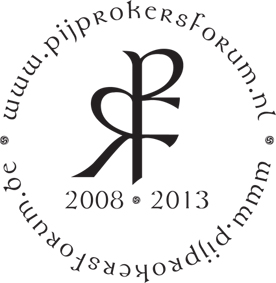 On August 24th 2013 the Dutch/Belgian Pipe Smokers Forum, of which I am an active member, existed precisely 5 years! This also means that I have been a pipe smoker for 3 years. I registered myself on the forum August 24th 2010 and started smoking pipe around that date. But the forum itself started earlier, in 2008. I have to thank Shaun for writing down the history of the Dutch/Belgian Pipe Smokers Forum. I only translated it:
On August 24th 2013 the Dutch/Belgian Pipe Smokers Forum, of which I am an active member, existed precisely 5 years! This also means that I have been a pipe smoker for 3 years. I registered myself on the forum August 24th 2010 and started smoking pipe around that date. But the forum itself started earlier, in 2008. I have to thank Shaun for writing down the history of the Dutch/Belgian Pipe Smokers Forum. I only translated it:
Who in early 2009 searched on the internet for “pijp roken” (pipe smoking) did not find much, A website of a pipe smokers guild with some practical tips on lighting and burning a pipe. Luckily there also was a fantastic website from Jan Kusters from the Dutch town of Sittard with its extensive and excellent “Pijpenboek van Janneman” (Pipebook from Janneman). Which later pretty much became the standard for every beginning (and more advanced) pipe smoker who spoke the Dutch language.
But… There had to be more??? Therefore on February 3rd 2009 a beginning pipe smoker frantically was searching for more tips, tricks and information about pipes and tobaccos on the internet. Result after result was clicked, page after page was carefully watched. Unfortunately, not at all complementary. Until suddenly in the depths of the Internet on page 10 of the Google searching results a pipe smokers forum popped up! Victory! The end of a long search, what a blessing it would be to receive a warm welcome by fellow smokers. But alas… The disappointment was great: the forum exactly had one member and a message. It was the smallest of all the forums at forum2go.nl, the initial host. After the first disappointment the beginning pipe smoker directly registered as second member under the forum name “Victor Baarn” and through a personal message contacted that first member, the admin: Pim123. Pim123 founded the forum on August 24 2008 as a learning experiment in how to create a forum. Since Pim123 at that time just was learning how to smoke pipe the forum became a pipe smoking forum by accident.
![]() Victor Baarn asked Pim123 whether he might attempt to make the forum bigger. Pim123 gave Victor Baarn the permission to promote the forum and conveniently made him moderator. The weeks after that the search on internet continued and Victor Baarn collected every e-mail address that even remotely had something to do with pipe smoking. A little over a week several dozen e-mail addresses were collected and on February 13th 2009 an invitation e-mail was send throughout the country and abroad (Belgium).
Victor Baarn asked Pim123 whether he might attempt to make the forum bigger. Pim123 gave Victor Baarn the permission to promote the forum and conveniently made him moderator. The weeks after that the search on internet continued and Victor Baarn collected every e-mail address that even remotely had something to do with pipe smoking. A little over a week several dozen e-mail addresses were collected and on February 13th 2009 an invitation e-mail was send throughout the country and abroad (Belgium).
And low and behold, the days after several new members applied, the first one (of course) being Janneman. But it did not go very fast.. Pim123 and Victor Baarn were busy opening new topics, the one after the other, in order to create conversations for the members. At first the forum looked more like a public dialogue between Victor Baarn and Pim123. So it was difficult in the beginning and in the first weeks it was to became clear if the forum would be viable. But luckily, despite the calm, there were some folks who kept on posting. Active members in the first days besides Pim123 and Victor Baarn mainly were Janneman, Antonius, dr. Watson, Joey Peters, Rob, Superpelic, Don Carlos, Bas and Vier Heeren Baai. A club of a few men who nicely chatted away with each other. Without their contributions the forum would not have been viable at that time. What definitely contributed was Janneman’s Pipebook for which he granted Pim124 permission to place it on the forum.
There was one certainty: that regularly, weekly a new member applied. Slowly but surely the number of members expanded. The more the merrier: more discussions and terminology. Google picked this up and pushed the forum upwards in the search results, thus creating new members. Another trick to promote the forum was that Victor placed links to sites about pipe smoking that scored high in the Google ranks. This resulted in more points in the search machine and… More new members. On Saturday September the 18th 2010 the first forum-meeting took place in Leerdam with an attendance of 11 members. After a few months the forum stood on page 1 of the search results. After that it went fast.
So fast that on November 7th 2010 Pim 123 announced that he had started the forum as an experiment and, now the forum had 200 members, would like to hand it over into more fanatical hands. Thus, on November 9th 2010 the fanatical DrFretboard became the new admin. And once again things moved fast. This time with regards to the technical progress of the forum. DrFretboard lifted the forum onto a higher technical level and introduced many improvements in the forum structure. Because of the busy traffic several moderators were introduced. The pipe smokers forum really grew up. The strict vision of DrFretboard about the forum led to a lot of discussions after a while. Dissatisfied smokers were found to be huge troublemakers. So on April 29th 2011 DrFretboard voluntary stepped down as admin with the question who was willing to take it over from him. After some discussions Nekker and Massis became the new admins on May 7th 2011.
From the beginning Nekker and Massis had a common target. First the human contacts, second to create the largest encyclopaedia about pipe smoking (in Dutch) that exists on internet. With that also the realization grew that the reigns had to be slacken. A more relaxed vibe sprouted and things started to fall into place. From this grew a hard core of people who not only got along with each other online but also in real life. Many initiatives proved this like mini-meetings, the Leerdam meeting etc. Then there was the big milestone in the forum history. Massis, who also takes care of the technical side of the forum, made the upgrade from the amateurish Forum2go to a professional forum. From then on everything kept on going forwards to (hopefully) never be stopped.
So in 2010 I was searching for info about pipe smoking and of course stumbled upon the forum which included Janneman’s Pipe Smoking Book. Eventually I registered and bought my first pipe and tobacco, which is described in my post Humble Beginnings Part 3. I am not a social kind of person. I have a mild form of autism, I stutter sometimes and being an only child is not really good for your communication skills. But the laid back vibe on the forum worked wonders with me, everyone was accepted the way he was and I became more open. Also the amount of metalheads was reassuring (and surprised me!), good folks!
I did not go to the first forum meeting in Leerdam, I only was a member for a short time. For the second one I initially said I could not come, but after some thinking I decided to go after all. Best decision ever. I stood before the old train station building in Leerdam where the meeting was organised and I was thinking like: “Arno, you really must be out of your mind.. You are in a town you have never been before and you are about to walk into a building where a meeting for pipe smokers is organized. And you know no one! Except for some forum posts of course.” Still I went inside and I had a blast! Very friendly people and I came to the conclusion that I could have a conversation with everyone because we all had one thing in common: pipe smoking.
And gradually real life friendships developed like with Ed (St Patrick). At the beginning of 2012 I left my car keys inside the car at Ellen‘s place in Olst while the spare keys were in my apartment in Oss where I still lived at that time. Nobody was willing or had the time to drive me so I could get the spare keys so in the end I desperately called Ed, who I then only just knew. “Oooh, well, then we are going to get the keys Sunday morning in Oss. During the ride we can smoke a pipe, relaaax.” I was flabbergasted.. And this kind of stuff characterizes the forum. The kindness, the generosity etc. etc. Of course there were some “hiccups” like the affair with DrFretboard. Also sometimes there are some differences of opinions but it is always solved in a civilized manner.
Because of the forum I crawled out of my shell and I became more social. Also the forum gave me a lot of creative impulses. After I won the “make a new banner competition”, organised by Pim123, I also made artwork for wallpapers, shirts, caps, more banners, business cards, mouse-pads, ashtrays, poker-fiches, dice, (forum)pipes and for some wonderful stone tampers made by Martin. Besides this I got motivated by the forum to combine some of my “old loves”, history and writing which resulted in this blog. Also I am still busy organizing the forum tobaccos.
So… Let’s go for another 5 years! And then 5 more and 5 more and 5 more……
Here are some pictures of meetings and mini-meetings from the years that I am a member:
Interview with master-blender Hans Wiedemann from HU Tobacco – Part 3.
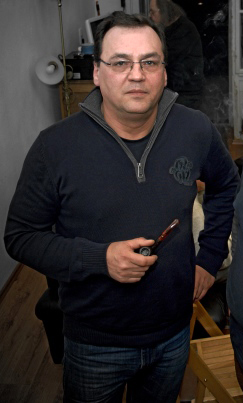 The final part. Continued from part 1 and part 2.
The final part. Continued from part 1 and part 2.
Did you ever imagine that your blends would be as successful as they have become?
Of course, I hoped that the tobaccos were well received. But that they would become so successful, even outside the borders of Europe, I could never imagine. That makes me very happy and is also the basis to go further and to make new mixtures. The nice thing about this success for me is that I rarely have a one-time-order customer. This shows me that it is not a hype, but that people like my style as a blender.
But the customer service is not to be underestimated. It is very important for me that the customer feels that he is in good hands and gets advise from me if he requests that. I also never had a customer take the damage or loss for a package and that creates confidence.
Which of your blends would you recommend for beginning pipe smokers?
Basically I recommend a beginner to first start with a pure, natural tobacco. I do not believe in the idea that everyone should first smoke an aromatic. Especially with aromatics one must pay attention to quality in order not to get terrible tongue burning tongue or sticky pipes. I would recommend everyone here Joschi’s Oriental Sunrise. It is an easy-to-smoke, medium-bodied tobacco with a nice sweetness without being intrusive. It is a simple blend but also a mixture that wants to be discovered. A client of mine calls Joschi’s a “listening tobacco” and that point of view I find very appropriate. It means that Joschi’s shall not impose itself on you but if you smoke it more often it has a lot to tell. Well, that would be my pick for the absolute beginner.
How are your blends received outside of Germany, do you sell a lot abroad?
My main business is of course in Germany, but my export share is estimated at about 40% and that is quite amazing. There are hardly any countries within Western-Europe to which I have not yet delivered. Eastern Europe is because of their customs and border regulations a white spot on my map, and this can not be changed. More and more tobacco goes to the USA. I am pleased when people buy from me again and again even though tobacco is much cheaper to get in their home countries. Because of that I know that there are real fans.
What are some of the changes that you have seen in the pipe and pipe tobacco industry over the years?
In the pipe industry, probably the biggest changes took place in recent years. When I look back on my past pipe-smoking life some traditional companies disappeared from the market or only the name was left without building on their own traditions. This is a natural market-process and it hurts me sometimes, but it also has to be.
On the other hand, the supply of hand-made pipes has grown immensely, not in the least due to the possibilities of internet. Basically I see this as nice, but I am not very enthusiastic. In principle the term “handmade” is not a synonym for quality. As a convinced unfiltered pipe-smoker it is of course very painful to see the extreme development of the industry towards the 9mm pipe filter. To come back to two of my favourite shapes, the Cutty or the Prince, this fact above is of course aesthetically not justifiable. These two shapes rely on their thin shanks, which give them their traditional elegance and lightness. This is a shame, but again I must add, the market regulates the demand and in this case the market has been manipulated.
Tobacco-technical changes are no less clearly visible. Some small tobacco manufacturers had to give way to the big suppliers. The supply of tobacco has increased significantly, but the diversity has been lost. The highly aromatic tobacco trend has kept pace with the arrival of 9mm pipe filters. Interesting is also the excessive use of sweet Black Cavendish and it seems that vanilla has become the standard flavour. I will not judge, but in my philosophy this does not match.
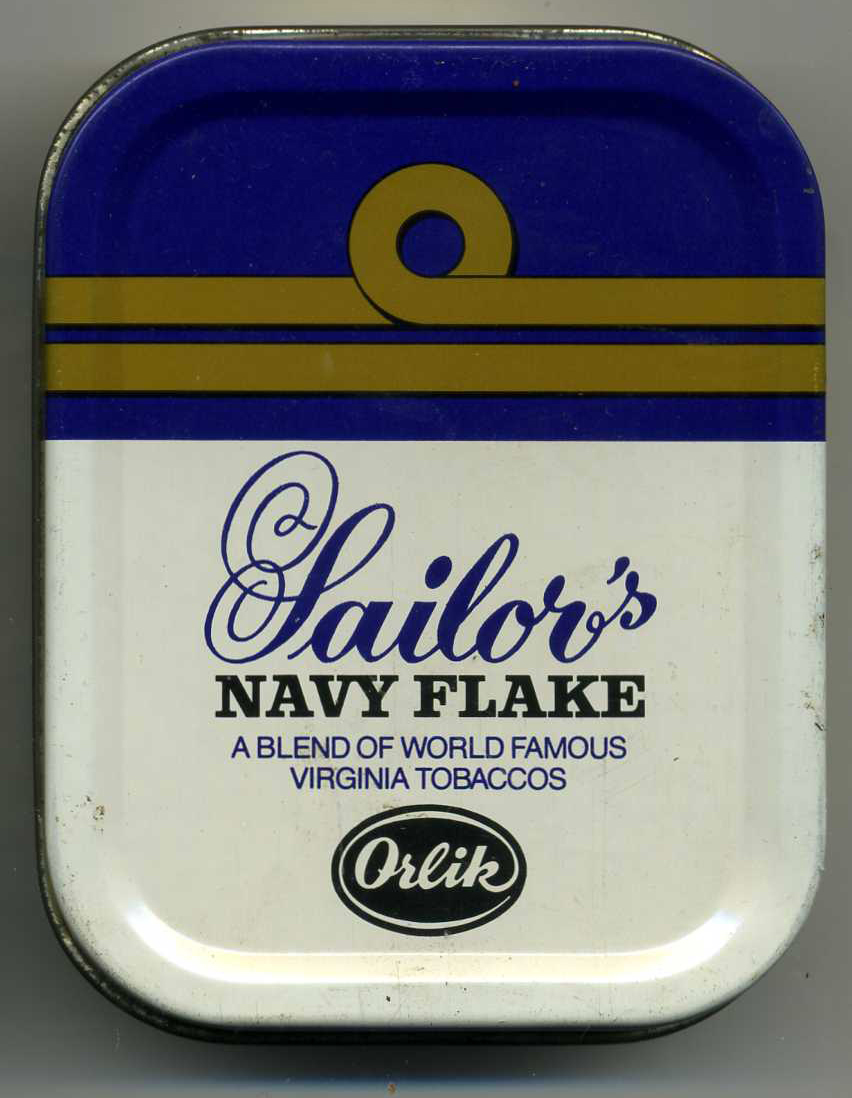 Some traditional tobacco disappeared from the market or have been changed beyond recognition and adapted for the mainstream. I will not give examples, but with sadness I think back at such great tobaccos as McConnell Original Red Virginia or Orlik Sailor’s Navy Flake.
Some traditional tobacco disappeared from the market or have been changed beyond recognition and adapted for the mainstream. I will not give examples, but with sadness I think back at such great tobaccos as McConnell Original Red Virginia or Orlik Sailor’s Navy Flake.
But exactly this fact has moved me to my actions. With my products I want to serve the small niche of enthusiasts of high quality and with love blended tobaccos. Although my offerings contradict all market analyses, HU Tobacco is very successful at the lowest level of sales. Now when I say that at me the percentage of British varieties with a significant amount of Latakia is about 60%, every tobacco retailer will shake his head.
The longer you think about the initial question the more you could add. But I think now that would be too much.
 I have heard and have seen for myself that a lot of younger people are starting to get into pipes. Have you seen a resurgence in pipes and pipe smoking?
I have heard and have seen for myself that a lot of younger people are starting to get into pipes. Have you seen a resurgence in pipes and pipe smoking?
Honestly, I can not comment on that. It would be nice if it were so, because pipe smoking is not only a question of taste but also a clear yes to living culture. But Arno, the impressions through the internet or a variety of forums can also be deceiving. One must never forget that forums / Facebook are a microcosm that has little to do with anything of the pipe smokers world. In these media really only the “freaks” roam. And their share is less than one percent, measured to the pipe smokers market.
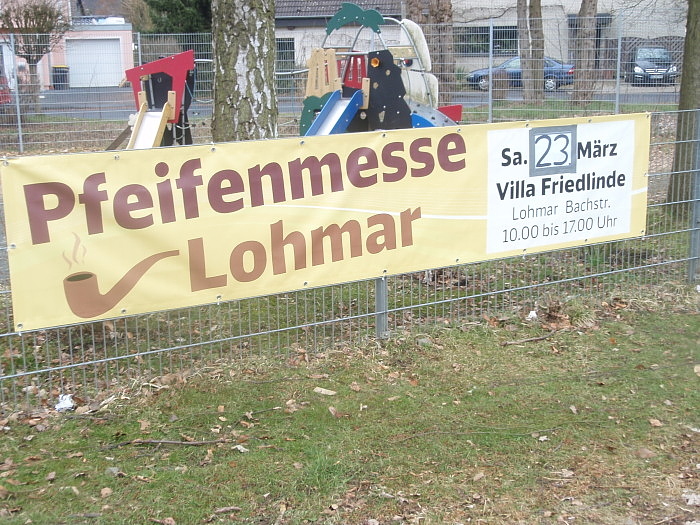 What are some of your favourite things about pipe shows you go to?
What are some of your favourite things about pipe shows you go to?
Pipe shows are of course always a good opportunity to introduce yourself to a wider audience and to showcase your products. This will benefit both sides. The customer has the opportunity to try tobacco without immediately having to order at me. Besides, such shows always offer the opportunity at times of personal contact to discuss tobacco. I always listen well to my customers to both the positive as well as the negative and to do something with feedback if possible. Although one can not always please everyone.
While smiling I think back to the last pipe-show in Lohmar. One criticism there was always that you could only buy my tobaccos in 100gr tins. This I have reacted to with the flakes what made a critical customer a bit angry. He shied away from the sale because 50gr tins were too small for him… Well, then you are just speechless…
Apart from the shows I always am pleased with the contacts with other exhibitors. As always we have a lot of fun, and only that makes a show worthwhile for me.
By the way, Lohmar is not too far away from Holland. Perhaps it even could be a destination for Dutch pipe clubs or forums 😉
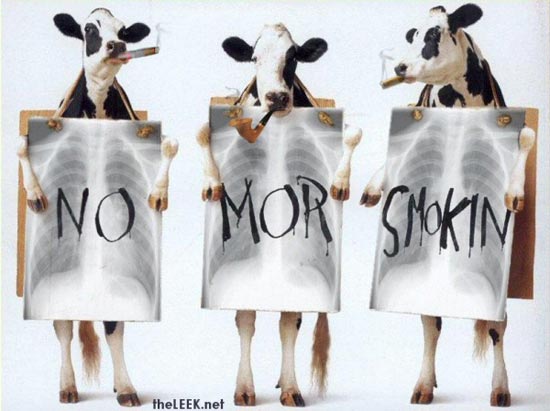 What are your thoughts on the whole anti-tobacco movement?
What are your thoughts on the whole anti-tobacco movement?
Honestly, I look very critical to this anti-tobacco movement since it is very hypocritical in my eyes. Of course we smokers were not very considerate in the past. But when it really was about health protection, it would have been possible to find a satisfactory solution for both sides with the ban on smoking in restaurants. But this has not at any time been the intention.
It’s not about health but it is a struggle against the solidarity of the society. No society needs the supposed good guy who points the finger at others in order to brand them as outlaws and set people up against each other. Once the smoking problem is solved other groups in society join the series. Alcohol, sugar, fat…… Everything is controlled by politicians to finally get an obedient, self-sustaining workforce; voting cattle. Mankind must be protected from themselves and everything than can be hazardous must be prohibited. Such a society I don’t want and I can only hope that the spirit of the age soon turns again so we can treat each other reasonable and sensible.
 Any last words to readers?
Any last words to readers?
Arno, now we’ve already talked quite a lot and I hope we have not bored the readers. So I want to make it short. Stylish pipe-smoking is a cultural asset that I really want to defend. With all the health risks it is also important to bear in mind that a relaxing smoke is balm for the soul so we can forget some of our troubles.
I therefore wish for all people who enjoy smoking pipe that they continue to enjoy our hobby and perhaps someone or someone else wants a mixture of me. Happy puffing!
You can buy Hans’ excellent tobaccos here.

















